Public Pier — No Fishing License Required
Due to damage to the pier during the ’23-’24 winters the pier is currently closed. It will not open until at least the summer of 2024. However, given the pier’s age, and structural damage, San Diego has approved plans to eventually tear down and replace the pier with a brand new, sparkling pier. The question is if the city will decide to make repairs to the current pier while the plans are finalized for the new pier or will it simply stay closed until the new pier is built. That answer has not been decided.
I should have been there (but I wasn’t). The date was July 2, 1966, the official opening day for the Ocean Beach Pier. Included in the 7,000 people who crowded the pier that day were local politicians, city officials (including Mayor Curran), and the main man, California’s governor, Edmund G. Brown who was scheduled to make the first cast from the pier. The San Diego Union reported the next day that Brown borrowed an angler’s rod, fished for five minutes, failed to catch a fish, and returned the rod. The angler decided to move! Just a short distance away, a large white cabin cruiser circled slowly around the front of the pier. On the side of the boat was a large banner reading “Reagan for governor” (and Reagan would defeat Brown that November). It must have been a sight!
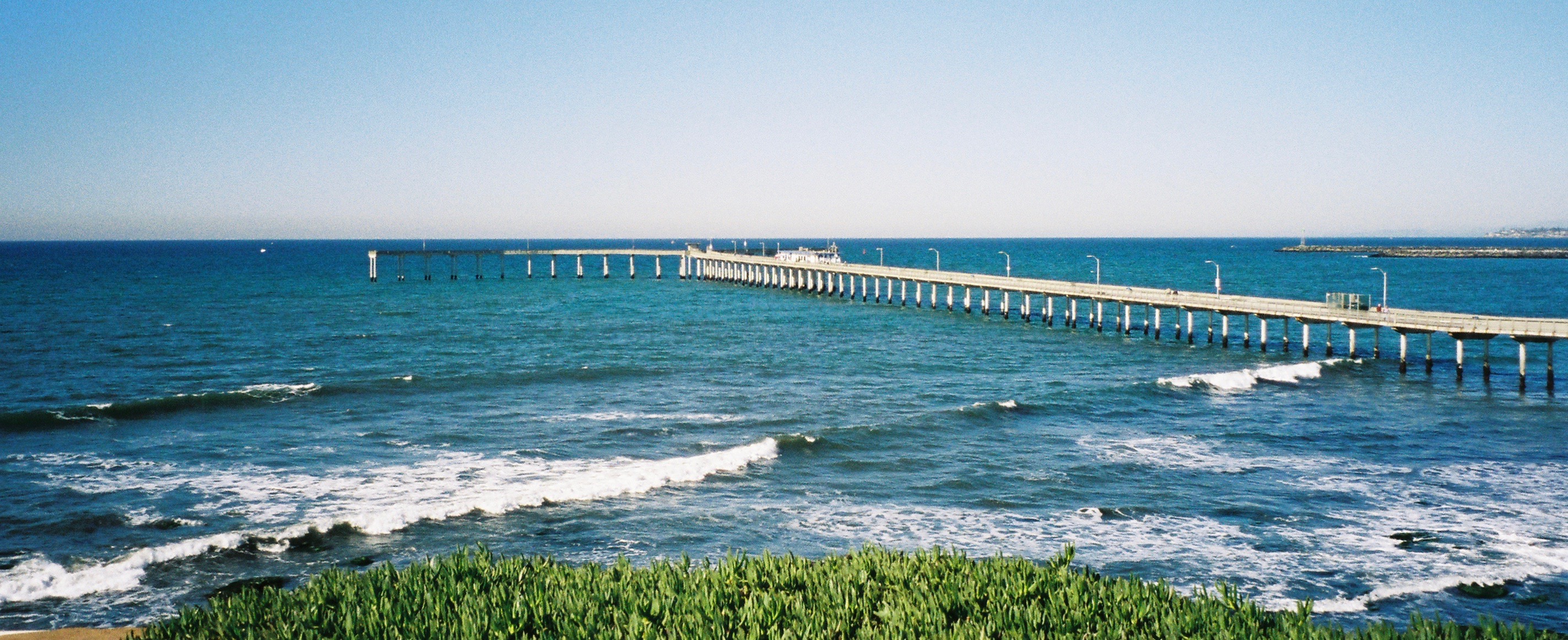
The first fish reported caught that day was an 8-inch sunfish (but since sunfish are freshwater fish, it was probably a perch of some type); next in line was a gray shark and then a crab. Not too impressive, but a start.
When it opened, this pier promised to be one of the premier piers in the entire state. It was long, providing nearly a mile of railing space, had full facilities, and it jutted out into the Point Loma kelp beds, one of the finest fishing areas in southern California. Anglers had visions of not only the smaller pier species but also larger game fish like barracuda, yellowtail (generally 5-10 pound firecracker size), white seabass and perhaps even a few giant black sea bass. Alas, although there are occasional glimpses of that promise, most of the days the fish and fishing is much like that found at other piers—fair to good but generally unexceptional.
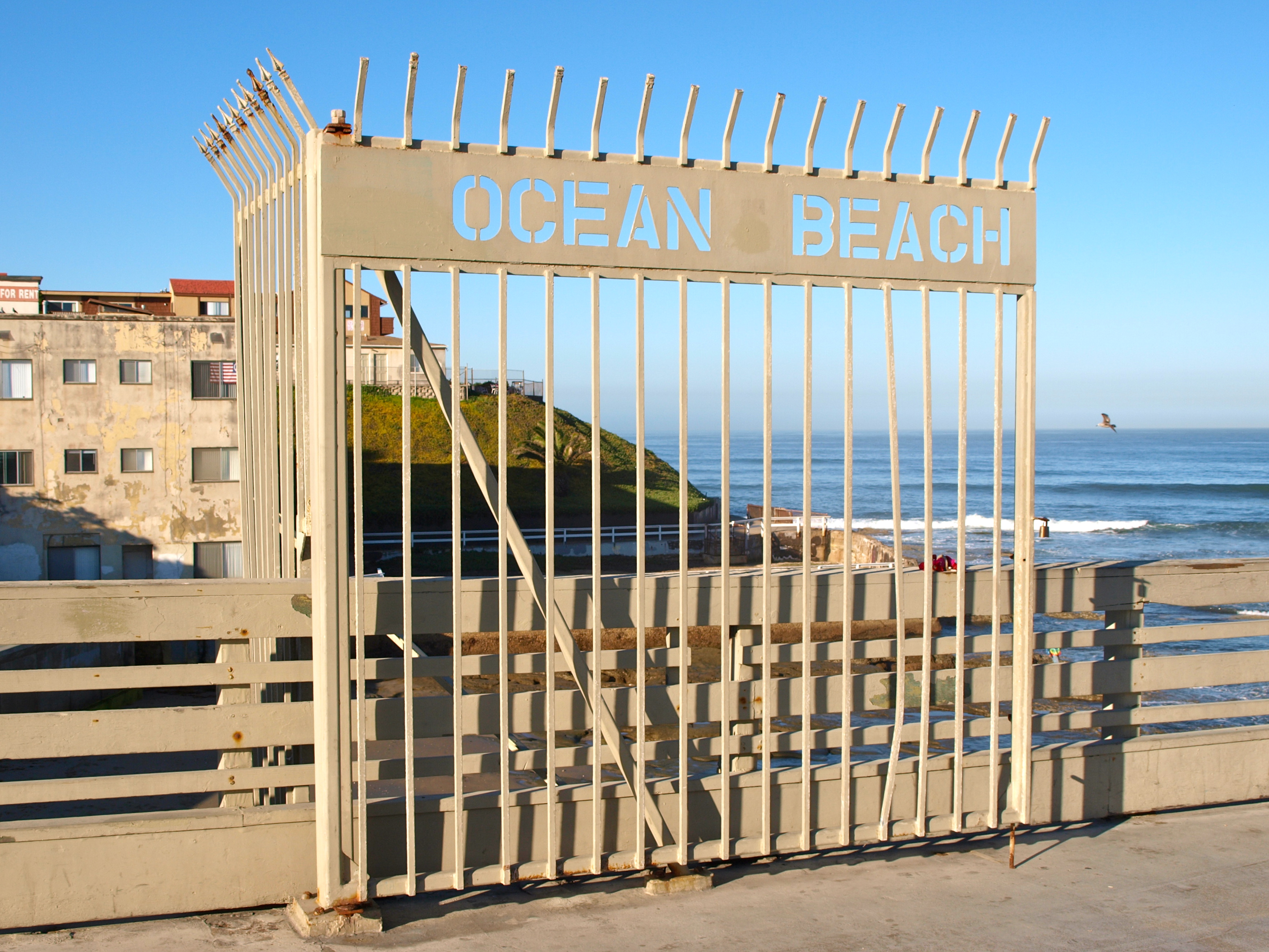
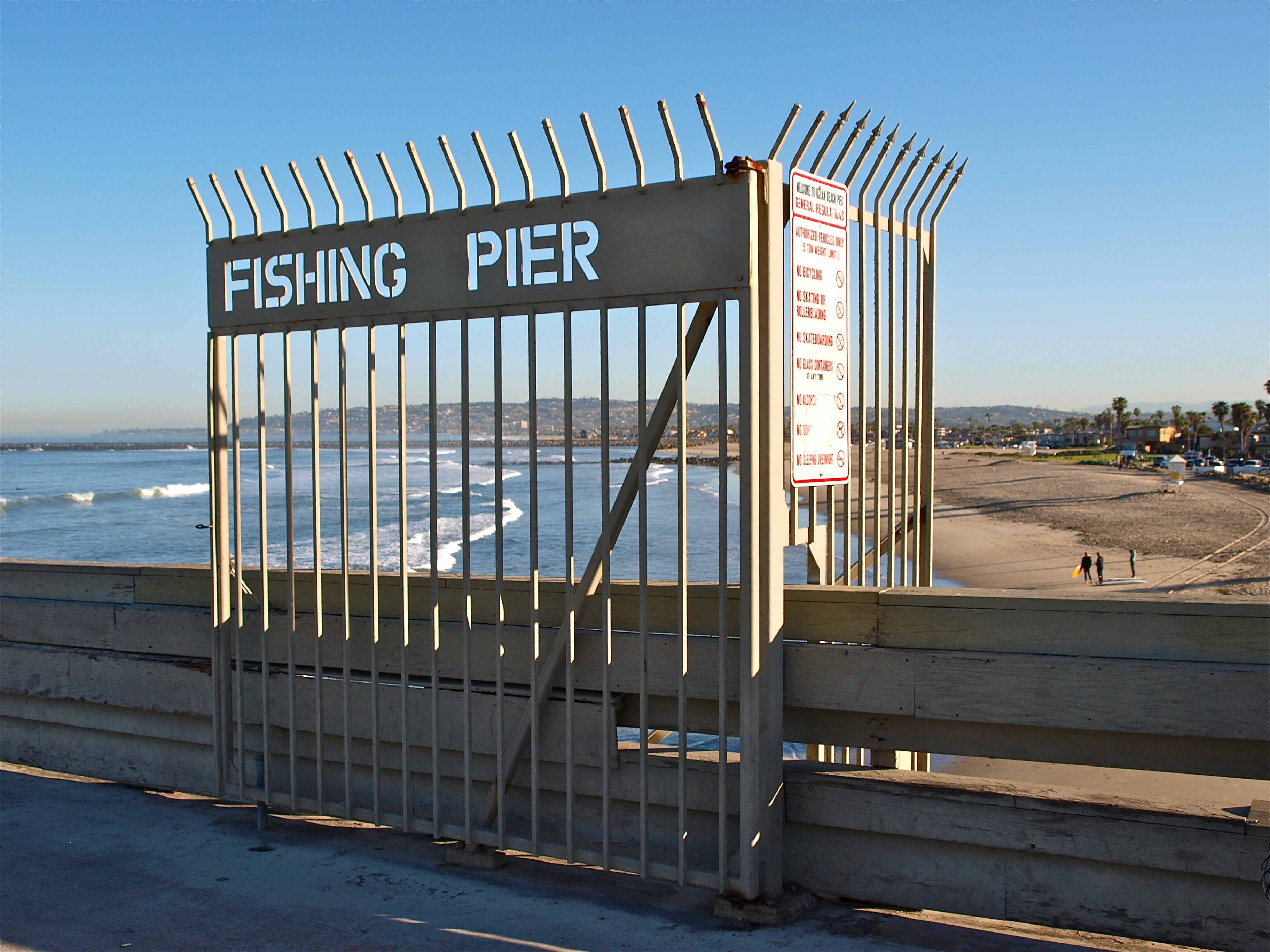
Personal experience would seem to substantiate those thoughts. My first visit was on August 6, 1966 and produced nothing but queenfish, a lot of queenfish. Several additional trips that year produced nothing but more small fry—white croaker, jacksmelt, walleye surfperch, jack mackerel and queenfish. Better results were obtained at Crystal Pier and so it was there that I would typically go unless at night when OB would be open while Crystal closed.
I wasn’t alone in those early disappointing catches. Apparently soon after opening anglers began to complain that they weren’t getting bites. In response, the president of the Peninsula Chamber of Commerce, Chuck Bahde, arranged for flattened junkyard cars to be dumped into the water by the pier. The cars became artificial reefs, improved the habitat, and evidently helped the fishing. I’m not sure where those cars were placed but I imagine all have long since rusted away.
Eventually (in 1967 and 1968) the larger fish did show up—halibut, bonito, shovelnose sharks (guitarfish) and barracuda, in fact quite a few barracuda. So, there are larger fish to be found at the pier but be realistic and do not expect to have the fishing match the size of the pier.
The stats — Although the points per hour figure (based upon MY personal records) is only 8.29, sixth among San Diego County piers and 55th among the state’s 130 saltwater piers, the interesting thing is that I have documented 69 different species from the pier, the highest number of any state pier (CA F&G surveys, KJ records, PFIC Monthly Reports, and PFIC Message Board reports). In addition, it ranks as one of the best piers in the state to catch yellowtail, barracuda, and sheephead while it is one of only three piers to record a dorado aka mahi mahi or dolphinfish being caught. Undoubtedly this is due to the pier’s diverse environments and the fact that it does (some years) poke into the kelp beds and sees the outer end pilings covered with kelp.
Environment and Fish. At 1,971 feet the Ocean Beach Pier is supposed to be the longest concrete pier in the world. The width is a standard 20 feet most of the length but it has a T-shaped end extending 360 feet to the south and 193 feet to the north. The size and location attract people, both anglers and sightseers, and according to some records it is tied for seventh among the most visited piers in the state.
It’s a long pier and not surprisingly presents several different environments—rocky, sandy, and those found in a kelp bed.
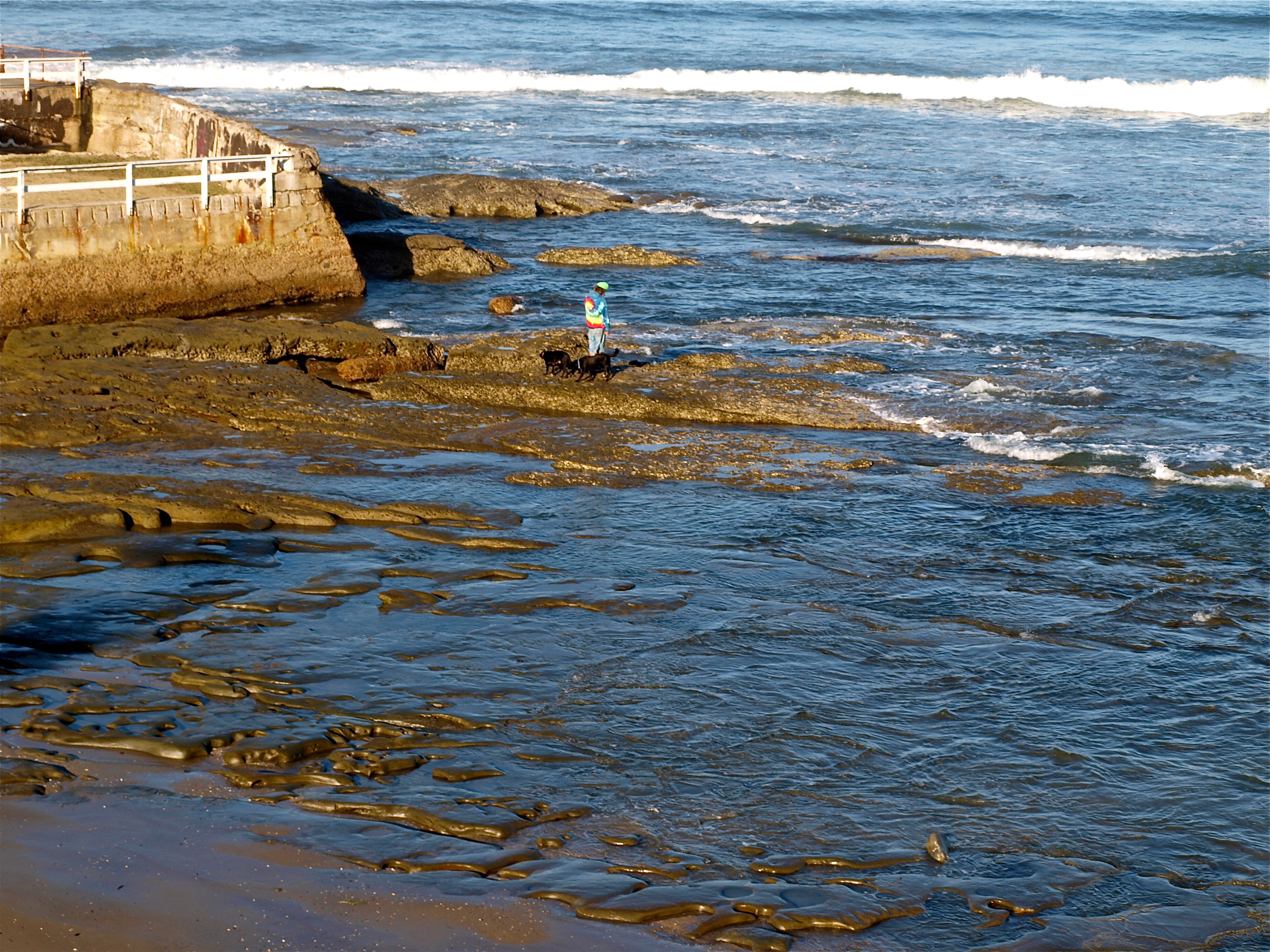
Inshore waters present a contrast in environments, at least at the foot of the pier. North of the pier is Ocean Beach Park, a typical sandy-shore beach, while south lies the Ocean Beach City Beach and Sunset Cliffs Park. Both of the latter are primarily rocky shore areas with each containing a series of small pocket beaches, some of which can be accessed by stairways. When young I used to fish from the Sunset Cliffs and was able to catch a wide variety of rock-frequenting species—bass, cabezon, perch, halfmoon, opaleye, kelpfish, etc.
Given that the front of the pier is built over this same type of rocky environment, there’s a chance for some of these same species. Unfortunately this rocky area is small and is basically a shallow-water area. When tidal conditions are right, high tide with small breakers, anglers are presented an opportunity to catch some fish. Low tides present conditions more conducive to exploring the tide pools.
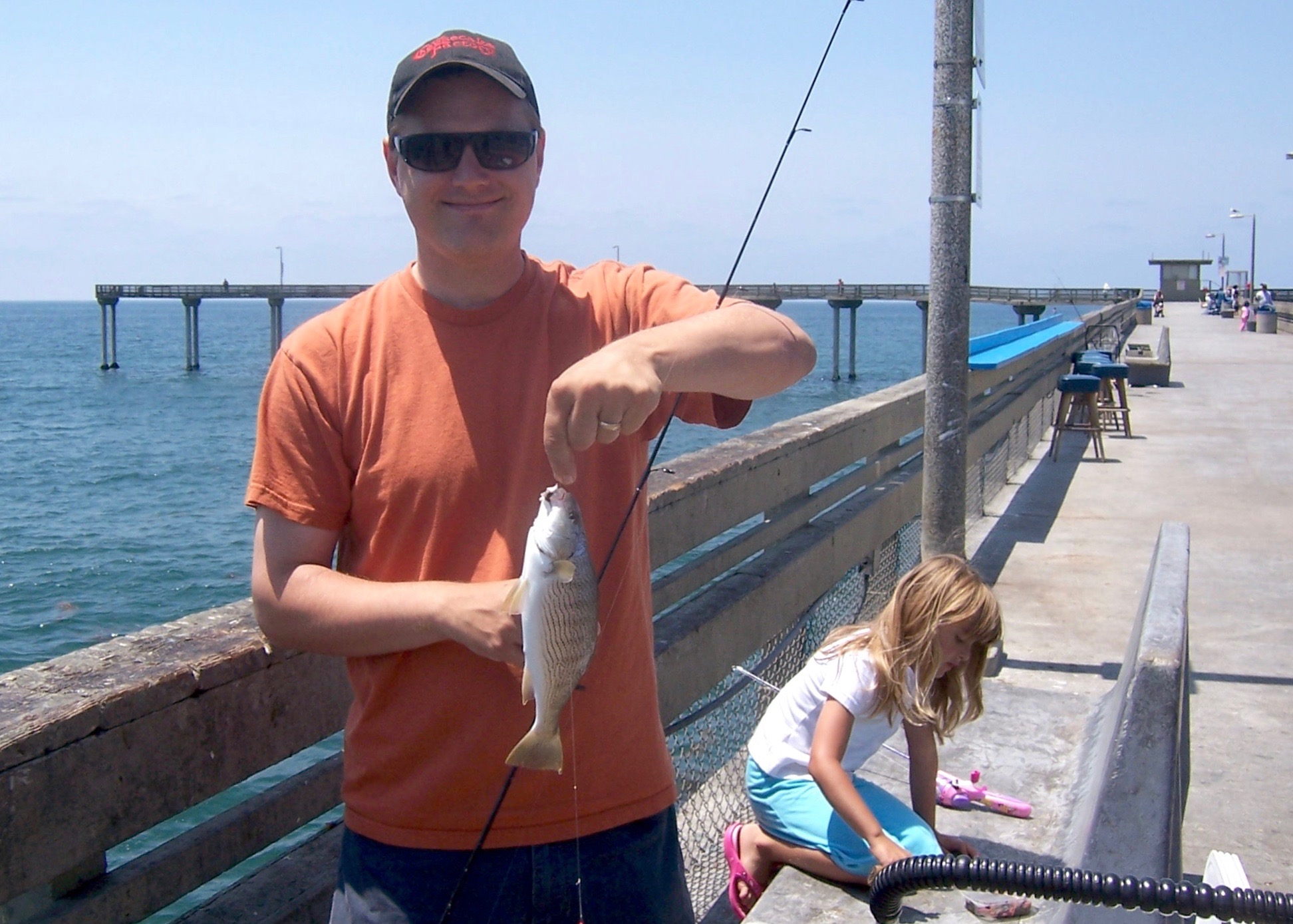
Yellowfin croaker taken by my son Mike. Granddaughter Serena is uninterested
A short distance out on the pier though presents a sand and mud bottom that means for the most part the normal sandy-shore species. Inshore you’ll primarily get some perch, croakers and sharays (sharks and rays). Midway out, on both sides of the bait shop, is the best area for the smaller white croaker, queenfish, jacksmelt, walleye surfperch, barracuda, mackerel and white seabass (usually the small, illegal, juvenile fish called sea trout).
This mid-pier area also seems to yield the majority of halibut (spring to summer), guitarfish and bat rays; it was in this area that I once caught a nearly 4-foot-wide California butterfly ray. Another day I got an uncommon, just barely 6-inch-long deepbody anchovy (Anchoa compressa) that hit a bait rig intended for mackerel. I believe there is a reef on the north side of the pier in this area, and that may explain why the majority of the fish seem to be taken on that side.
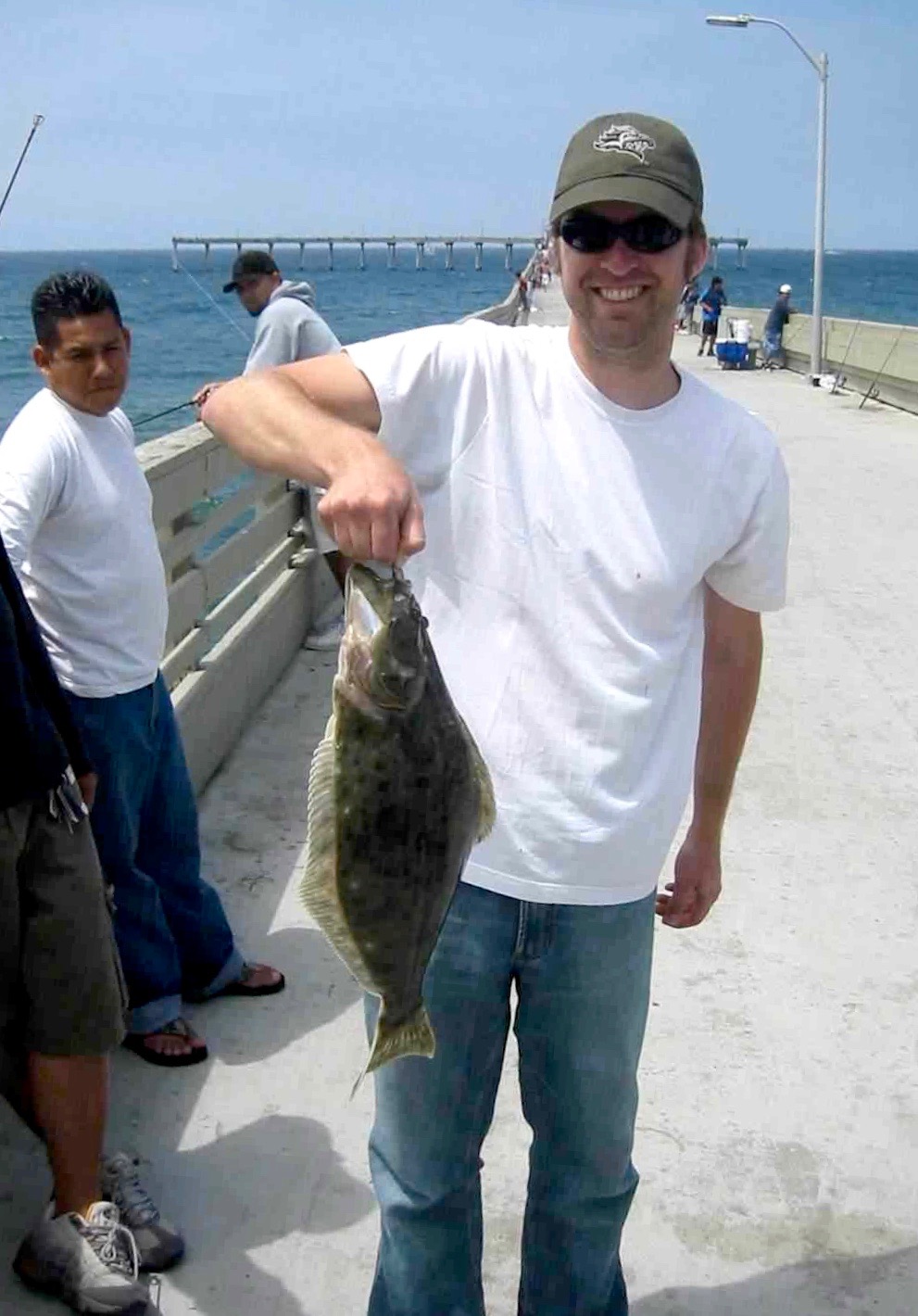
The far end extends into the Point Loma kelp bed and is blanketed by kelp much of the year. This can attract some kelp resident species but can also cause a lot of tangles, usually at the most inopportune time—such as when you have a large fish attached to the end of your line.
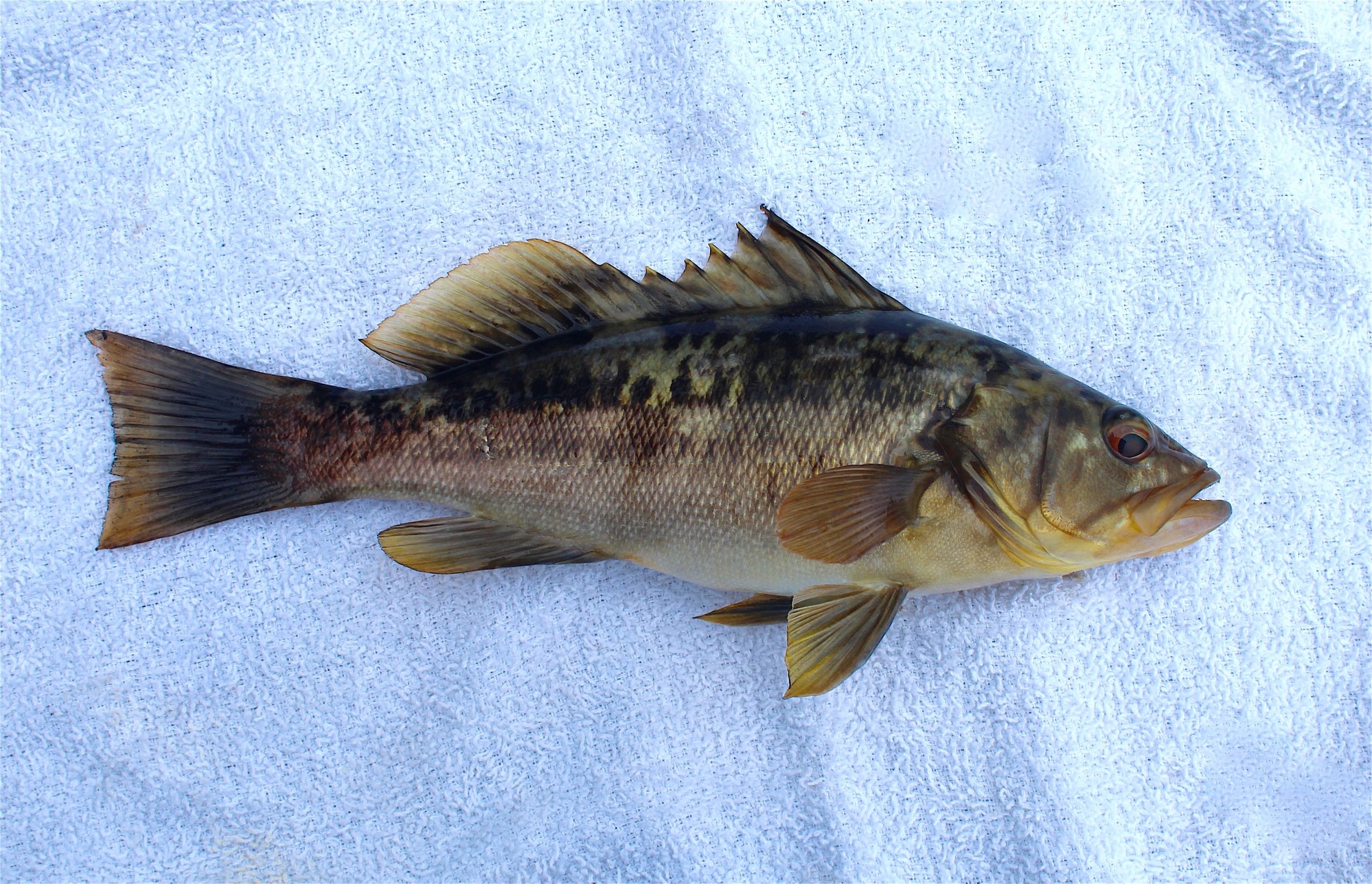
Kelp Bass aka Calico Bass
At this far end, where the water is 25 feet deep, the most common species are kelp bass, sand bass, several variety of perch, bonito, mackerel, scorpionfish, and, quite often, California lobster (which are illegal if taken on a line). Unfortunately during warm-water years the kelp beds may diminish in size, which can mean less fish — but also less tangles (there’s always a trade-off).
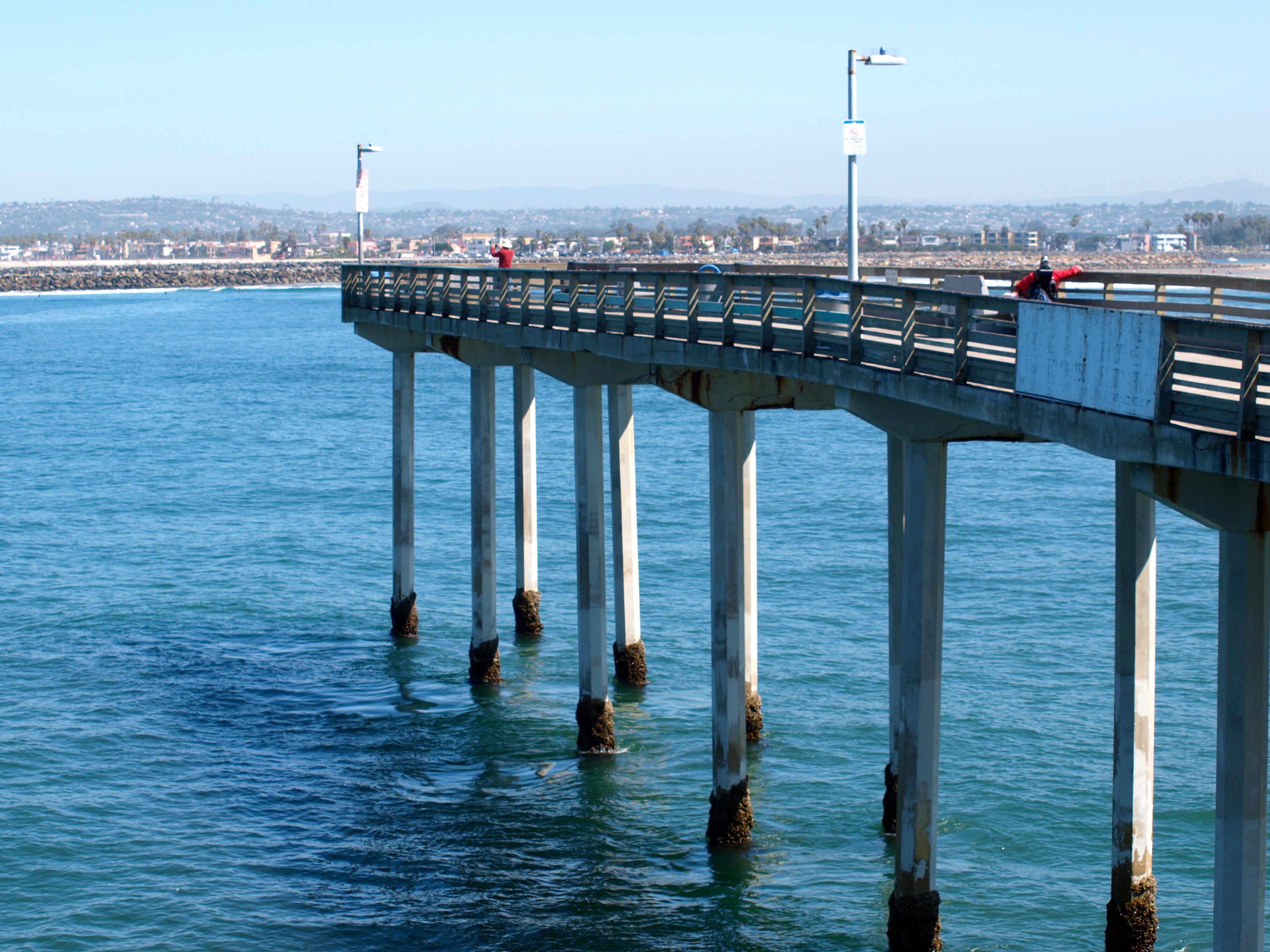
Occasionally a black sea bass (giant sea bass) will also pass through this kelp bed area. The first PFIC report of a blackie at the pier was in August of 1997, a 9-pound baby that was caught and quickly released back into the water. Since then the number of the giant sea bass that are hooked and released seems to multiply each year. Two of the large bass, estimated at 80-pounds each, were taken in May of ’09 (one on a live queenfish, one on a chunk of mackerel), followed in the same month by a fish estimated to weigh 150 pounds. Who knows, maybe it’s the mamas and the papas of that little 9-pound youngster? Then again, how big might he or she be after all these years?
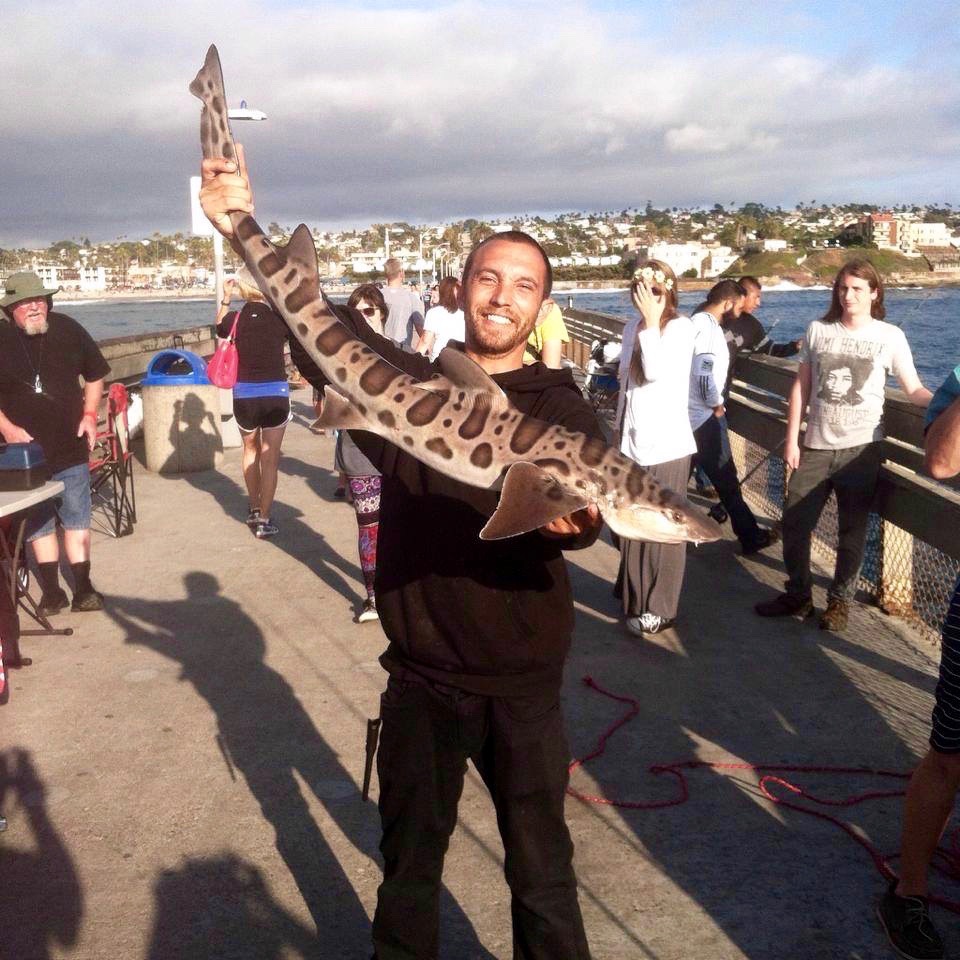
Leopard shark taken in 2016
The pier receives a lot of angling pressure (more than 500,000 visitor-days of use per year) but, because of the length of the pier with more than a mile of railing space, it rarely feels crowded. Regulars used to include such characters as Halibut Harry, Bonito Man, Buffalo Kid and Big Mama, but the cast and names change with the times.
Something that doesn’t seem to change is the antics of the sea gulls. Never leave your bait unattended because the robber gulls will quickly swoop down and grab anchovies or similar baits. Best to cut a piece of bait and then put the rest of the bait back into a cooler.
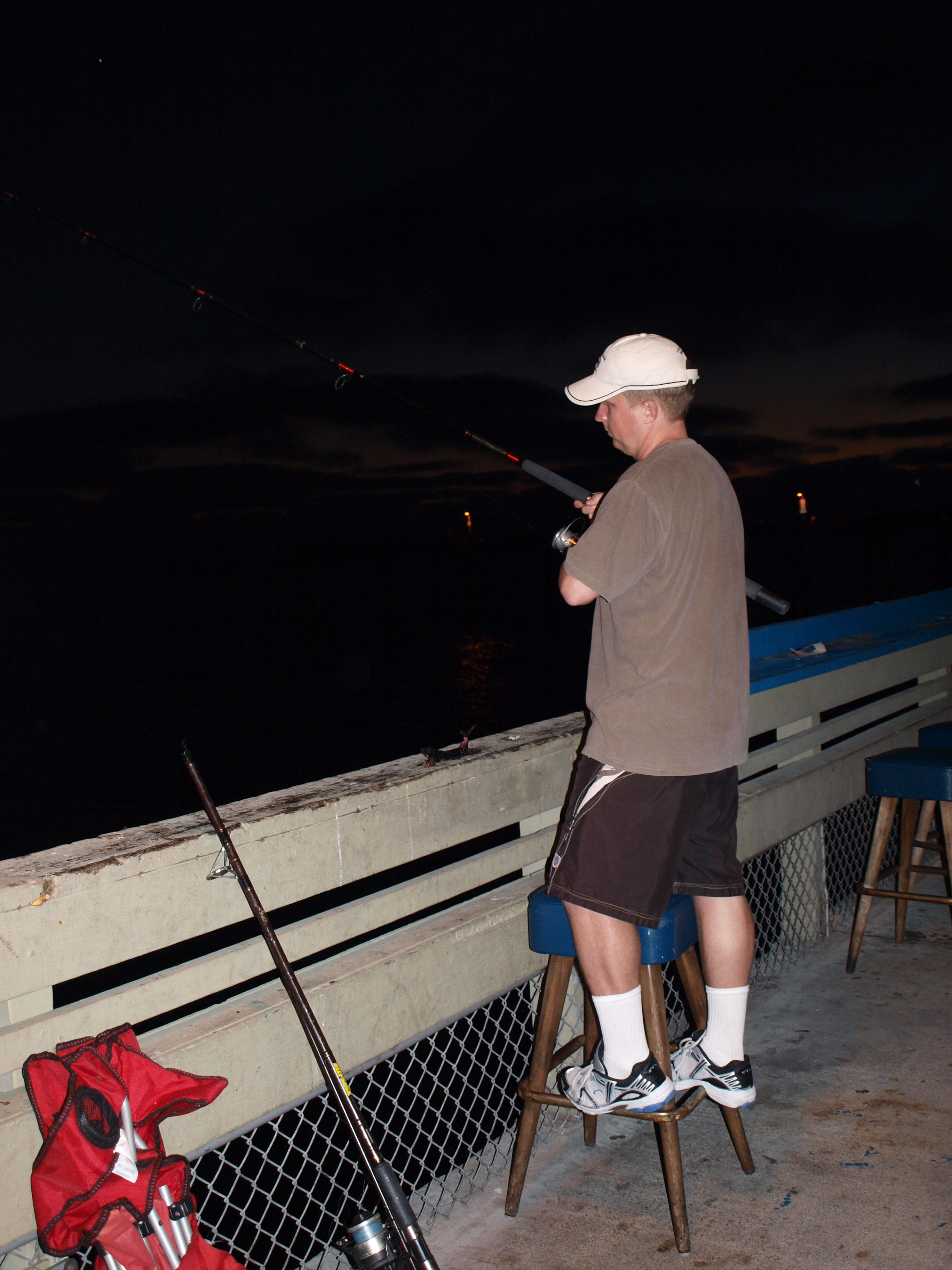
OB Pier Rat
A final important consideration regarding the environment is the behavior on the pier. One visitor to my web site reported that a popular California fishing guide mentioned that it was unsafe to visit this pier at night due to unruly thugs. This was news to me! Although I had spent many a long night on the pier back in the ’60s, recent trips had rarely extended beyond 10 P.M. In checking with the local “experts” it is fairly apparent that there were some problems in the mid-’90s due to transients using the pier at night for their lodgings. However, tactics changed. The police now use bicycles to patrol the pier (thus not tipping off their arrival), and 24-hour parking has been set up adjacent to the pier, which seems to cut down the number of people on the pier at night. Also, and this was a big factor, no alcohol is allowed on the beach or on the pier. Thus it is generally safe to visit the pier at night.
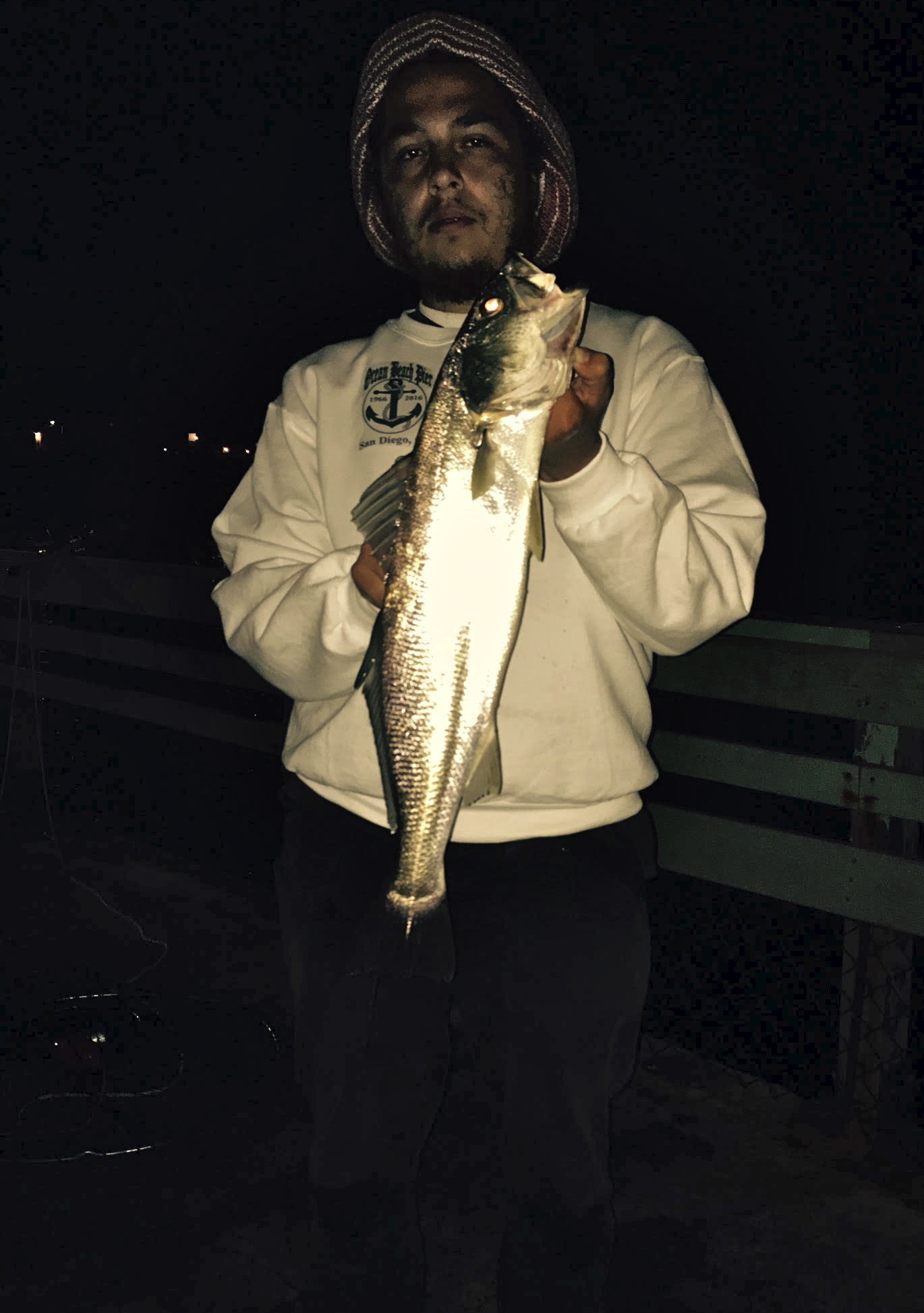
Shortfin corvina caught in 2016 by Angel
One of my favorite descriptions of the pier and its environment is a poetic one given by Janice Lee in her excellent blog titled ENTROPY. Herein a few excerpts:
Ocean Beach Pier at night, recalls a certain image. I always remember one particular night when it was red tide and so the incoming tides and subtle movements of the water revealed a strange and eerie glow, the small but numerous bioluminescent dinoflagellates causing the water to glow blue. The same night the pier was full of people fishing, different colored glow sticks tied to the ends of their lines for visibility. And amidst the already eerie symphony of light and darkness, the fireworks from Sea World started to go off. I’m somewhere else, I thought. It was utterly chaotic: all of the different lights and people and flopping fish and voices and boom boxes, and it was utterly beautiful and calm: the darkness, the glow, the perfect home for ghosts and their sorrow…
At the end of the pier, it is like you are at the end of the world. Standing on the southern tip, there is only darkness and infinity. If you stand in the right position, the lights of the city don’t even exist anymore. This is the ocean that can swallow you whole without flinching, without anyone noticing. You could disappear into the blackness, and here, no one would ever notice. Is this a similar kind of loneliness to the terrifying solitude of outer space?…
The sun setting behind the clouds create radiant rays of light that burst outwards like the cover of a religious pamphlet. These are the kinds of scenes that can be used to justify the existence of God, the kind of beauty that can be described as holy, sacred.
—Janice Lee, ENTROPY, The Poetics of Spaces: Ocean Beach Pier, June 26, 2014
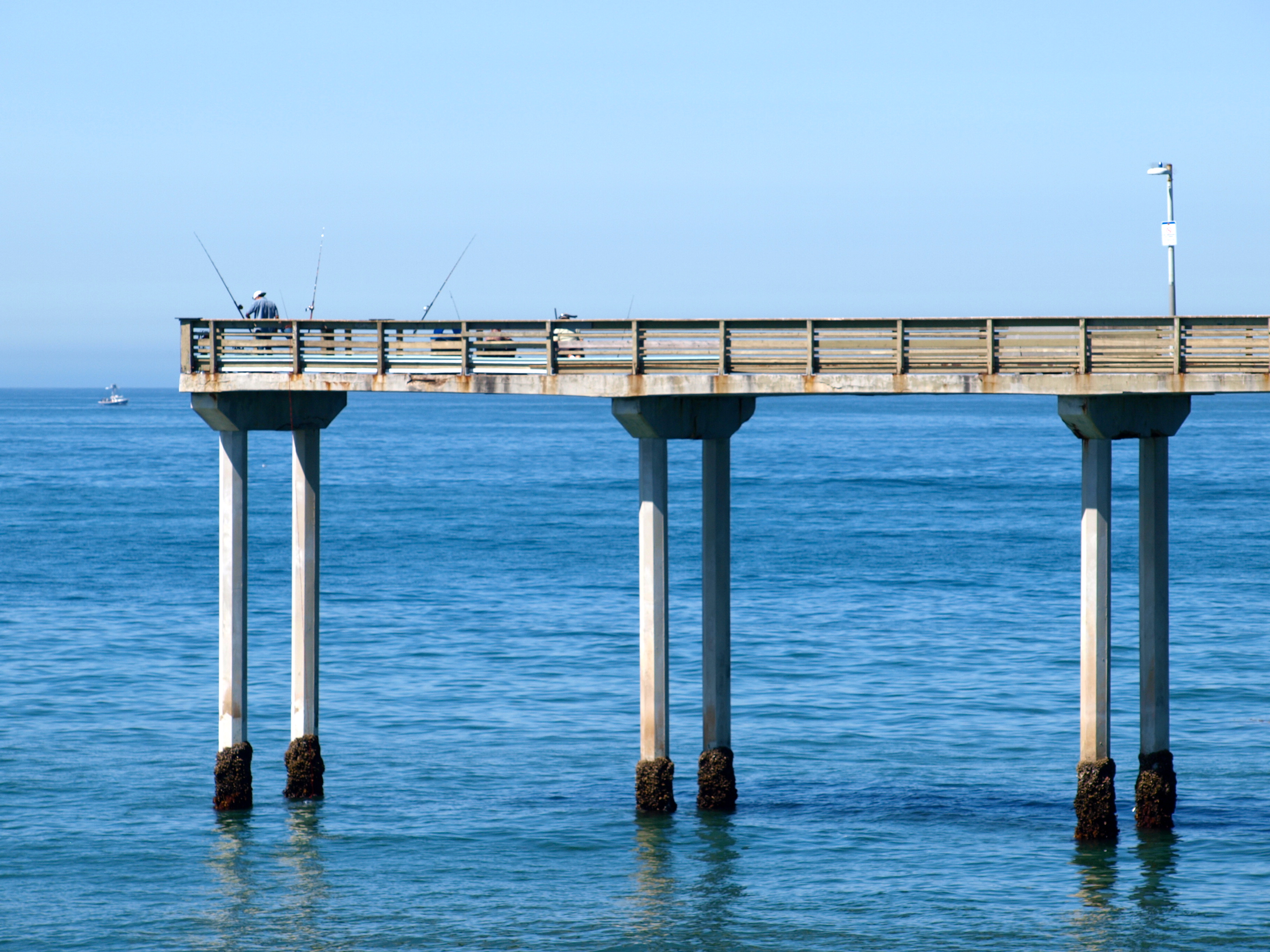
The left corner is considered the “primo” spot for several species including sharks and sheephead
Fishing Tips. At the far end of the pier, in the deepest water, are found some of the biggest fish. Several pelagic species—bonito, barracuda and yellowtail—like the combination of deep water and kelp, while several bottom species—kelp bass, sand bass, sheephead, and sculpin (scorpionfish) seem primarily attracted by the kelp.
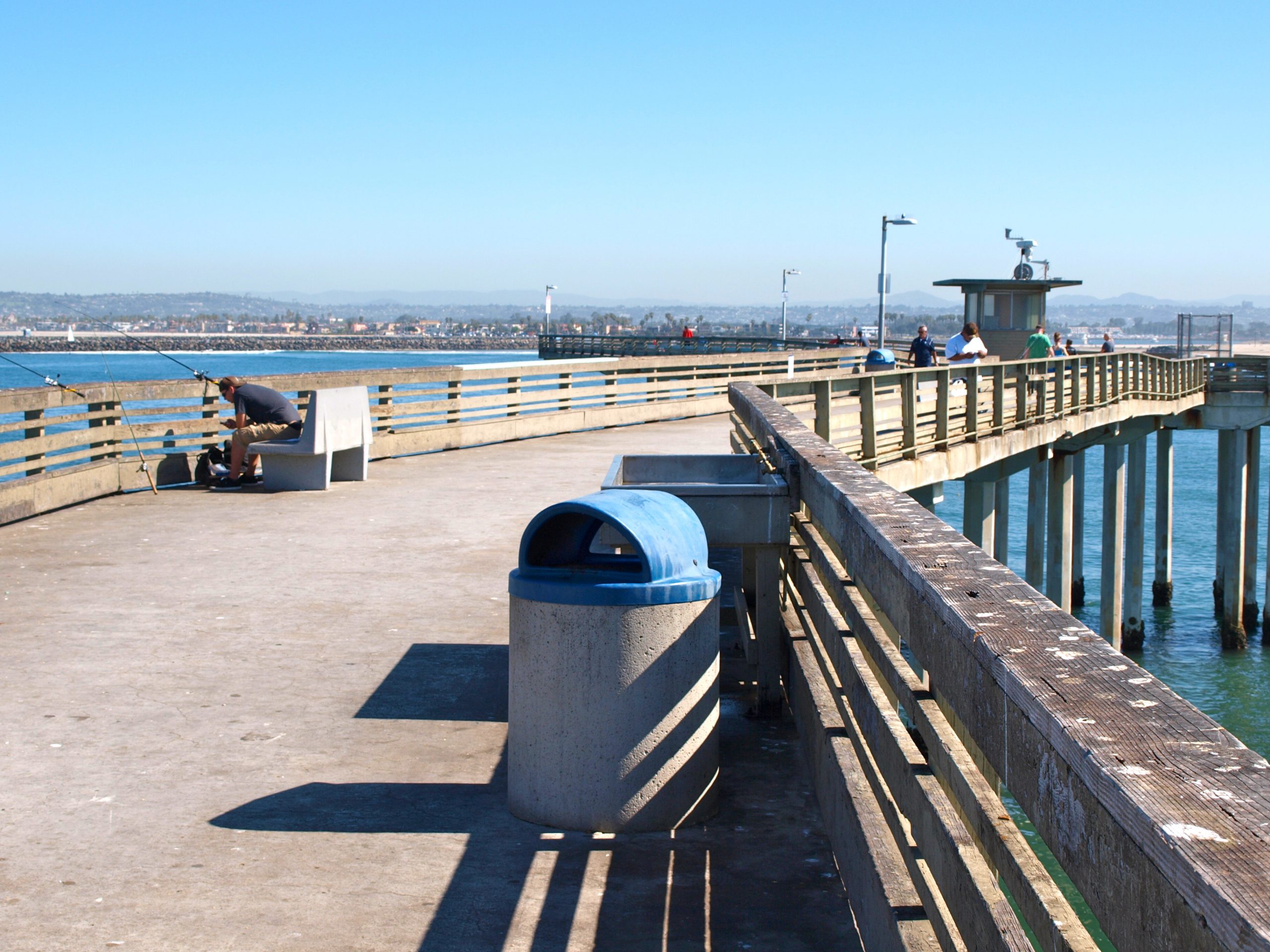
The bonito will be abundant some years and be absent other years. In the ‘60s they were almost too numerous and people would complain that they were crowding out the “better” fish. Then, when they did a disappearing act for many years, people lamented the loss of these great game fish. In the ‘90s, and into the new century, there have been good years and bad years. Strangely, several of the last few years have seen runs of micro-bonito, small fish that were uncommon in the past. They’re supposed to spawn off of Baja and no one, including scientists that I talked to, seemed to know why baby bonito were showing up at SoCal piers. But, we’ll take them! When the medium to large-sized bonito show up, the best rigging seems to be a feather trailed behind a Cast-A-Bubble (or golf ball) or a jig such as a MegaBait, Crippled Herring or Buzz Bomb. Micro-sized bonito are young ‘uns and perhaps not as sharp, they will hit bait rigs, often several at a time. But why, since you’re are limited to five small bonito, use a bait rig? One cast might yield your limit.
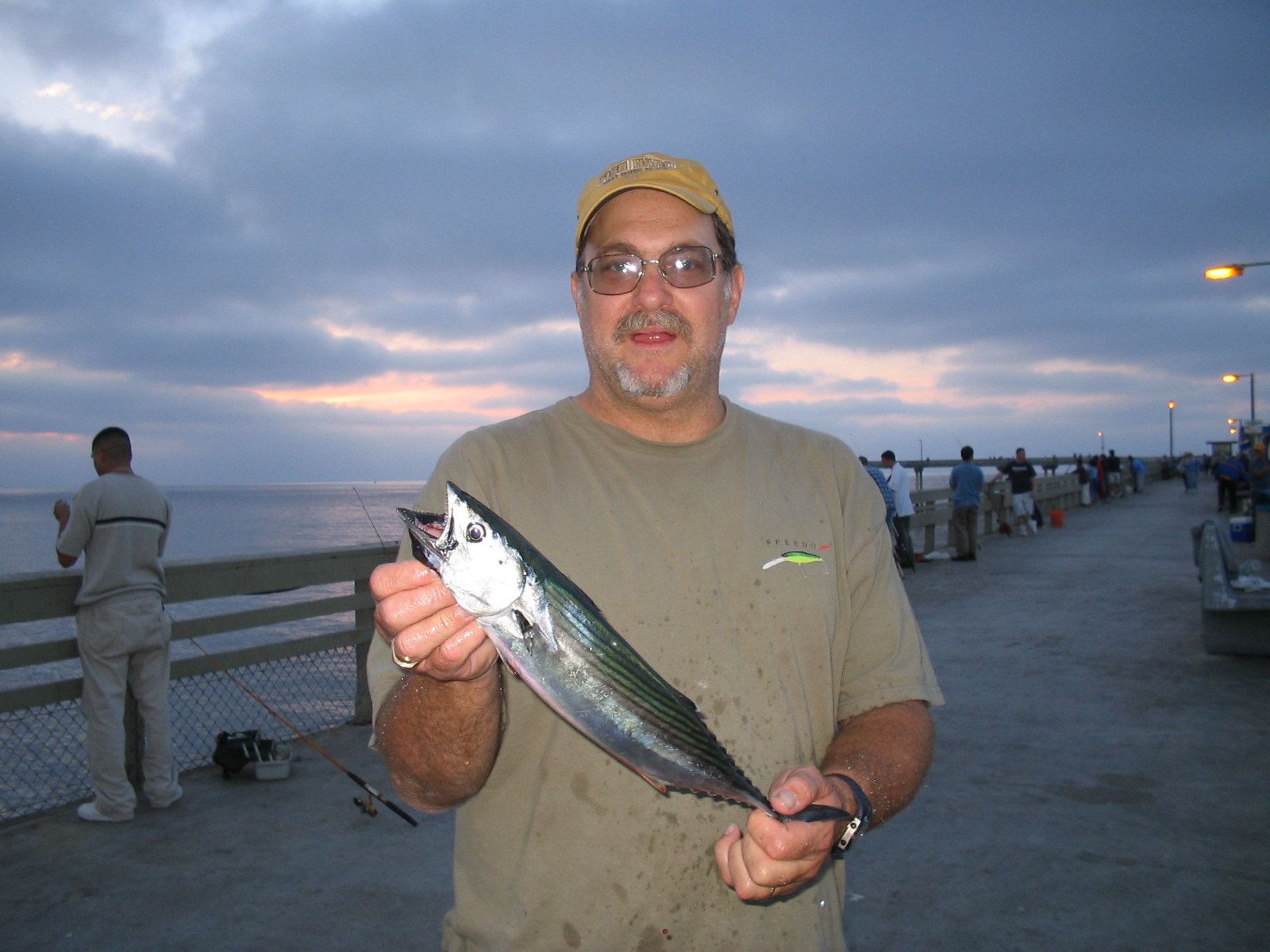
Bonito caught by Mike Donahue
The barracuda also like the end area but will be found all the way down the pier to the bait shop area. They show up almost every year and are most common in the fall and at night. Nevertheless there can sometimes be great daytime action depending upon how the schools of bait are hanging around the pier. Bets results on the barracuda seem to be with gold or silver-colored spoons like a Krocodile but other artificials are also used with MegaBaits and Rebel Fast Tracks leading the way,
Yellowtail are the trophy fish although most pier fisherman will never land one. However, they do show up most years, generally between July-October, and their appearance can quickly galvanize the pier rats into a state of apoplexy. Pier rats are soon tossing out whatever metal creations happen to be found in their tackle boxes, hoping to lure the ‘tails into their coveted section of water. The yellows for their part usually show just enough ‘tail to entice and tease the excited anglers. Then they disappear. Still it is fun while it lasts and adequate numbers are caught most years to keep the hope alive. Several methods are time proven: (1) Live bait, a still lively jack mackerel or Pacific mackerel (small) that you’ve caught with a bait rig. Use a sliding leader or a leader with a float. (2) A leadhead jig that has a strip of mackerel 1 1/2 inches long by 1/2 inch wide attached to the hook. (3) Artificial lures such as Crippled Anchovies, MegaBaits, Rebel Fast Tracks and Buzz Bombs.
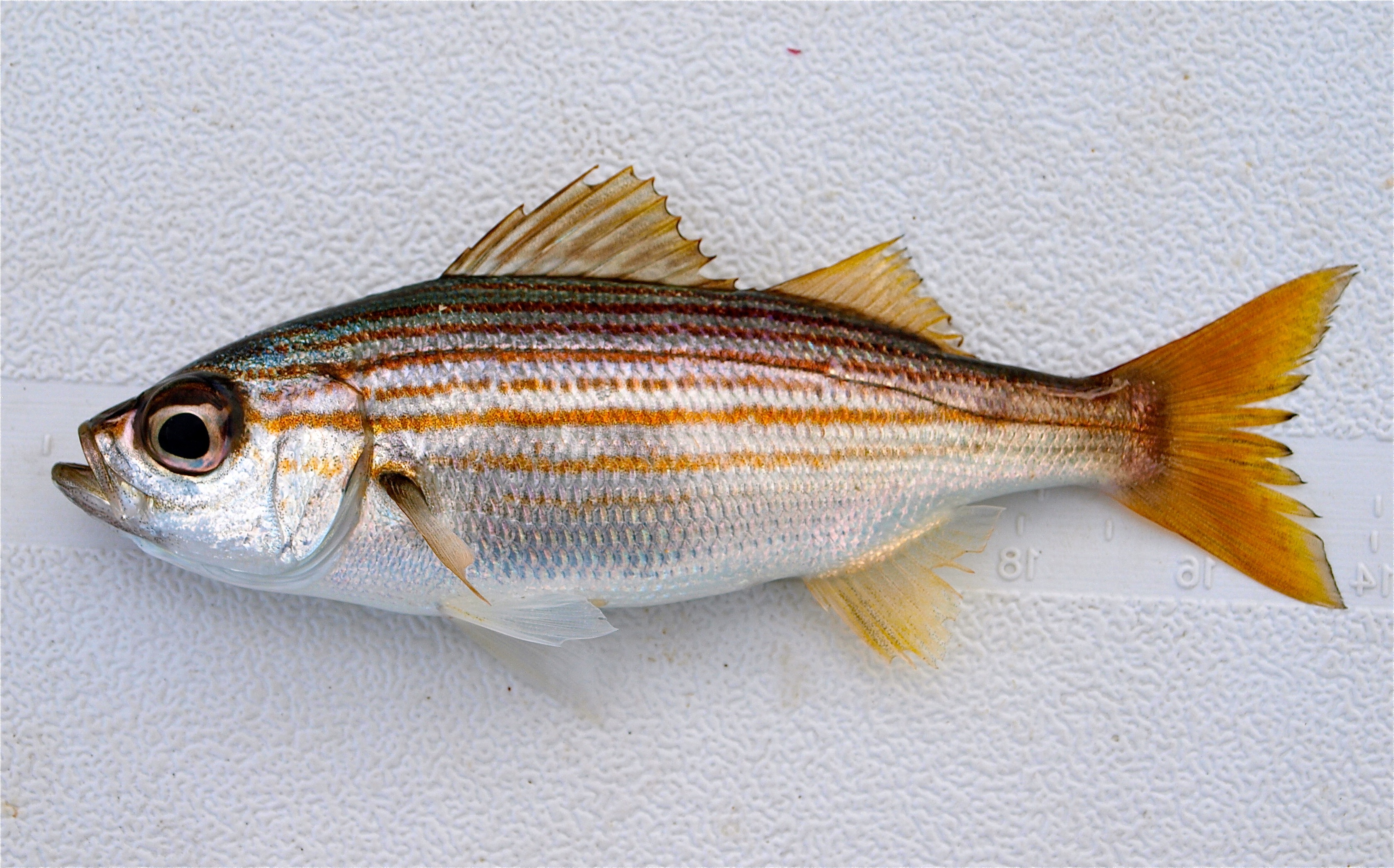
Salema are common out toward the end
Pacific mackerel are common from the end almost into the shallows. If you’re after the macs, the most common rigging is a single size 4 or 2 hook baited with a strip of squid or a piece of mackerel. A few feet above the hook is a small split-shot sinker. Many people also use bait rig leaders (Sabiki and Lucky Lura being most common). The bait rig is also good if Spanish mackerel (jack mackerel) show up. I’ve heard reports, but never seen pictures, of a few bullet mackerel (Auxis rachei) being landed at the pier during warm water years. As for myself, I usually just use a high/low rig with size 4 hooks and a torpedo sinker. Two macs at a time quickly fills the bait cooler and I don’t feel like spending the time untangling a bait rig or, even worse, having a $3-4 rig tangled into a Gordian knot that requires an Alexander-like slice through the mess with a sword, ahh bait knife.
Most of the biggest sharks and rays are also caught at the end. Best bait is squid or a bloody piece of mackerel fished on the bottom; be sure to use fairly strong (30+) test line and tackle. Shovelnose guitarfish, bat rays, and some of the bigger sharks (like threshers) are common. As is true at almost every pier, the nocturnal, nighttime hours are the best if you’re seeking these denizens of the deep.
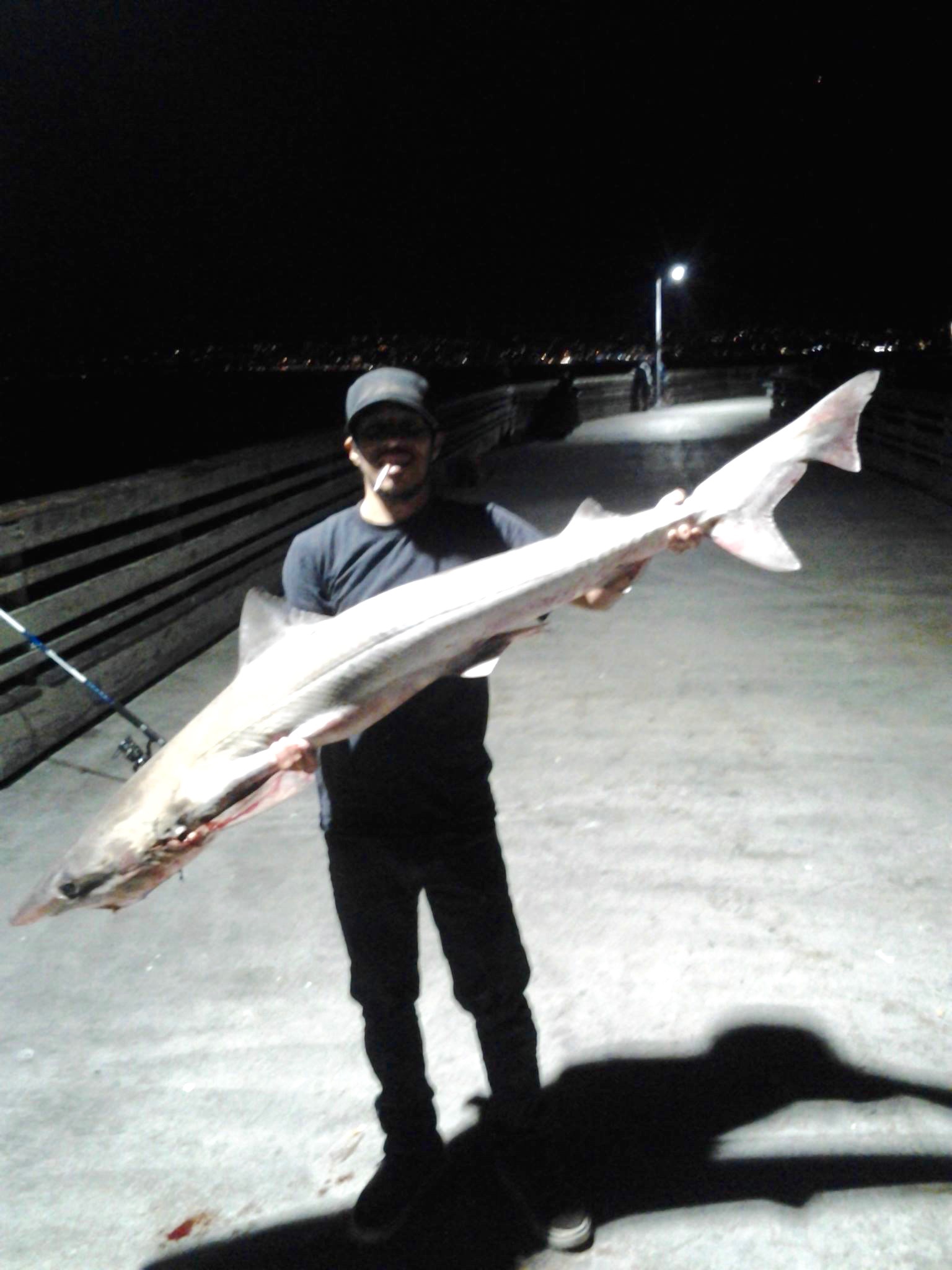
Soupfin shark (Picture courtesy Wicked Homies Fishing Club)
A reputed hot spot for the shovelnose sharks (guitarfish) is the left branch at the very end of the pier (called “Spyglass Point” by some anglers and “Shark Alley” by others). One angler reported that a right side corner-cast, as far out as he could cast at a 45 degree angle, often produced large shovelnose sharks with many exceeding 30 pounds in size.
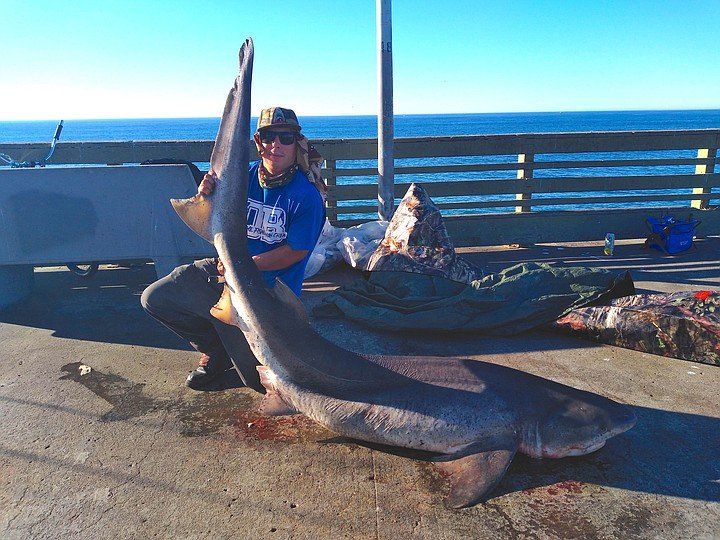
7-Gill Shark caught by Danny Reid in July 2020 (Picture courtesy Wicked Homies Fishing Club)
In May of 2006 a nearly 8-foot-long, 112-pound 7-gill shark was caught by Omar Garcia in the area. In September of the same year Inez Chavarin landed a 7-foot-long, 100+pound thresher shark. May of 20 7-gill, this one estimated at 150 pounds, was caugh at the end by 08 saw the capture of a 7-gill estimated to be 10-10 ½ feet long. The only problem is that 7-gills are only supposed to reach about 9 feet in length. Perhaps it was a 6-gill (they’ve been reported to 15 feet in length)? Several more 6-foot and up 7-gills were taken in December of 2009 and they seem to have become a yearly catch. A large 7-gill caught in 2016 made the news on local TV stations — https://www.youtube.com/watch?v=KRTWQ0yk2WY. Another 7-gill, this one estimated at 150 pounds was taken at the end by Julian Beltran on July 2, 2023.
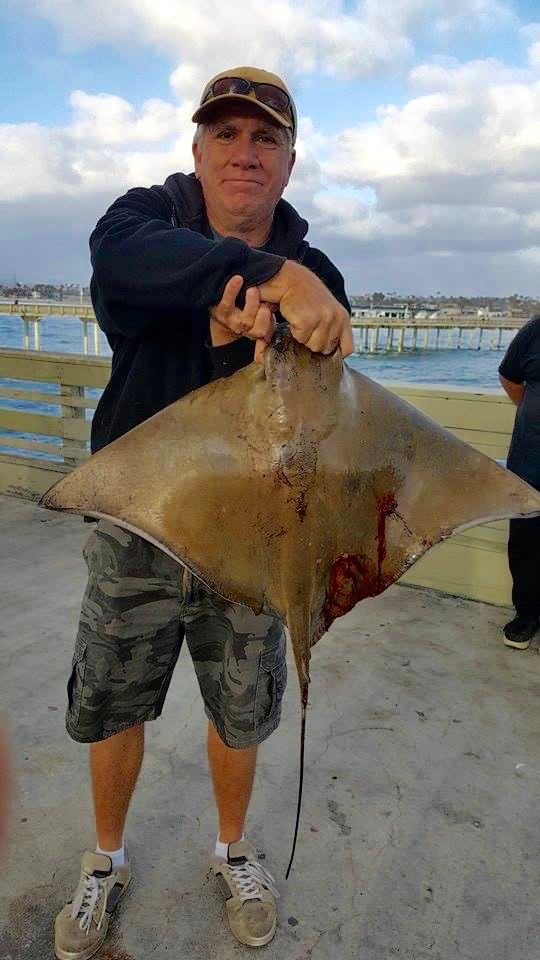
Bat ray (But please do not hold a bat ray like this, hold it by the mouth)
A 160-pound bat ray was taken in May of ’09 while a 7-foot-long blue shark was landed in August of 2010. And a tip—several of the large fish seem to have been taken around the evening setting of the sun, a time that often coincides with the appearance of the mackerel.
The left end corner also seems to have been the most frequent spot for catching sheephead and many of the buck-toothed critters have been taken including a 15-pound fish in October ’09. Best bait for them seems to be either live ghost shrimp or pieces of market shrimp. In 2006 a legal-sized salmon was also taken in this area.
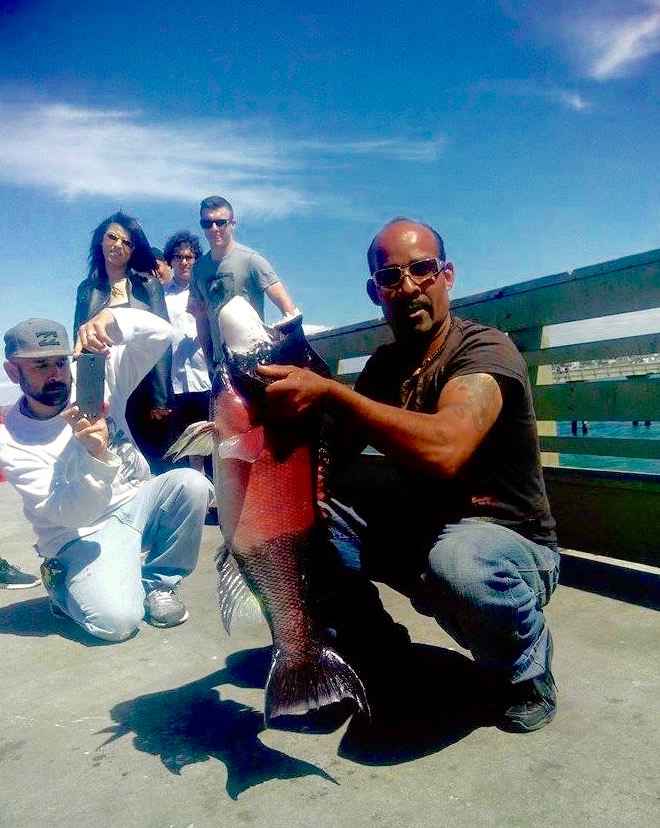
Sheephead taken by Jose in 2017 (Picture courtesy Wicked Homies Fishing Club)
Sand bass, calico bass (kelp bass), sculpin (scorpionfish) and halibut are possibilities while fishing on the bottom or at mid-depth levels out at the end of the pier. I also received a report of a 4-foot-long moray eel taken from this area in May of ’99 together with a large reddish-colored fish that remains unidentified. An occasional grass rockfish, kelp rockfish, olive rockfish (Johnny bass) or cabezon will also enter the catch.
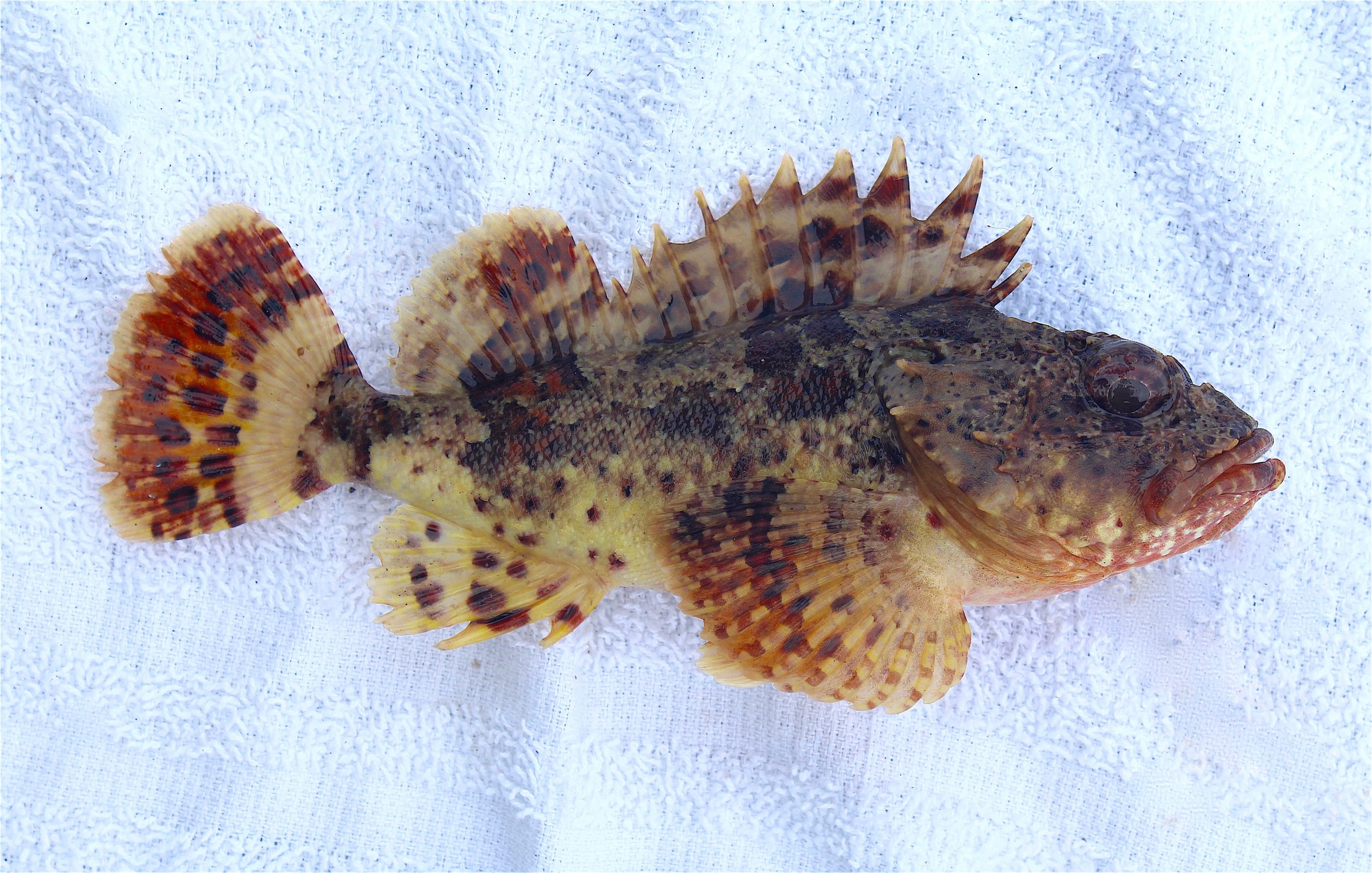
California Scorpionfish
In May of 2007 several giant squid were hooked from the pier but alas none of the anglers was using line strong enough to reign in the beasts.
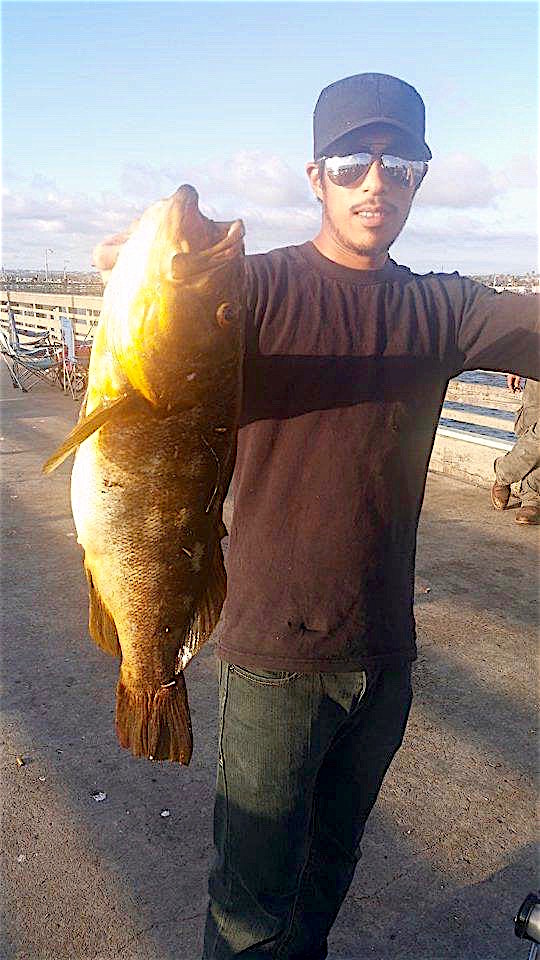
Kelp Bass (Picture courtesy Wicked Homies Fishing Club)
When fishing midway out on the pier, your best bet for the larger species is once again live bait. Halibut will often lay in the depressions between the pilings while eyeing the schools of small queenfish and walleye surfperch up above (and a 38-pound flattie was landed in August of 1998, a 44-inch halibut in September 2006). Catch the queenfish (herring) and walleyes with multi-hook bait rig leaders (size 6 or 8), or make your own snag line (tie 3-4 small hooks directly to your line, about four inches apart). Fish the snag line unbaited, or sweeten it with a small strip of anchovy (or a very small live pinhead anchovy or smelt).
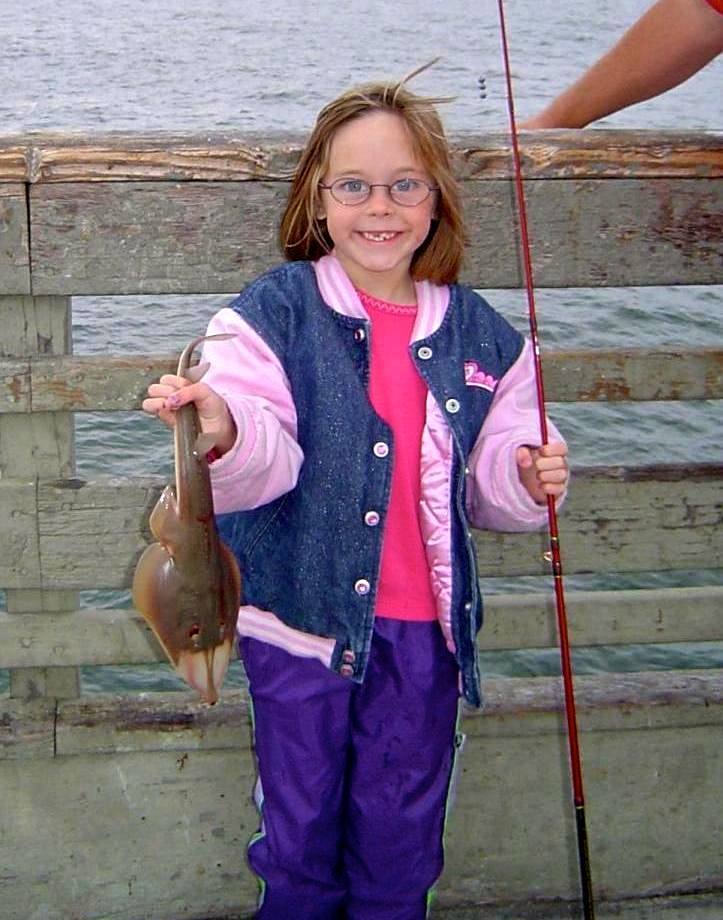
Haley’s first shovelnose shark (guitarfish)
A lot of shovelnose guitarfish and bat rays will also be hanging out in these waters feeding on the queenfish (and a 57-pound shovelnose was reported in July of ’99). Don’t be afraid to try artificial lures if the pier isn’t too crowded (I saw a picture of a 30-inch halibut taken on light tackle by an angler using a pearl-colored Fish Trap lure).
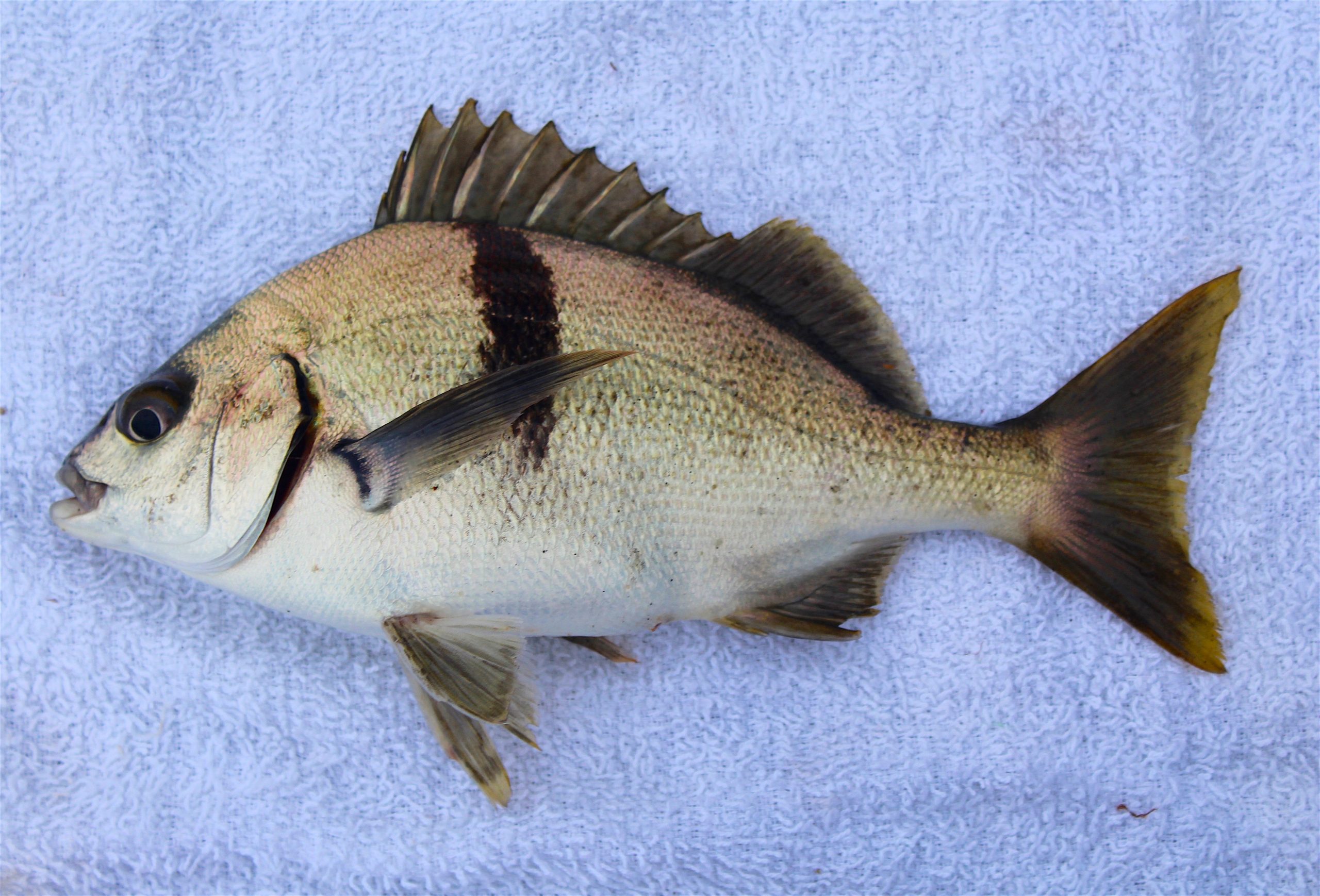
Sargo
Some years will also see fairly good runs of sargo in this area; try a high/low rigging baited with pieces of shrimp, ghost shrimp, bloodworms or fresh mussels.
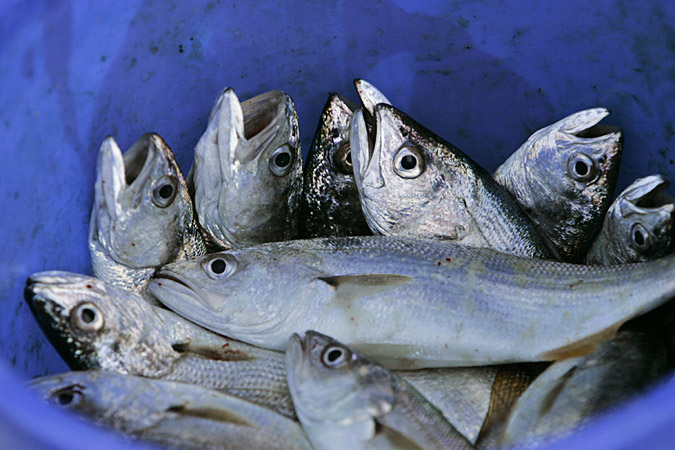
Queenfish
Quite often you will find both sides of the pier loaded with anglers in this area, especially both sides of the bait shop and restaurant. Many are whole families fishing for small herring (queenfish) and they will fill buckets with the small but tasty fish. There is not a limit on the fish and it’s a good thing for them because at times they will have hundreds of fish.
A short way out on the pier, just past the breaker area, and where the pier surface ends its descent and begins to level off, is a large, green colored wire cage. This area, primarily on the north side, seems to yield a lot of leopard sharks, some of which have been pretty decent in size (including a 57-inch, 36-pound leopard in September 1997). Fish on the bottom using squid, mackerel or similar strong flavored (and smelling) bait. Don’t be surprised if you also see a few shovelnose guitarfish, thornback rays, round stingrays and bat rays in this area.
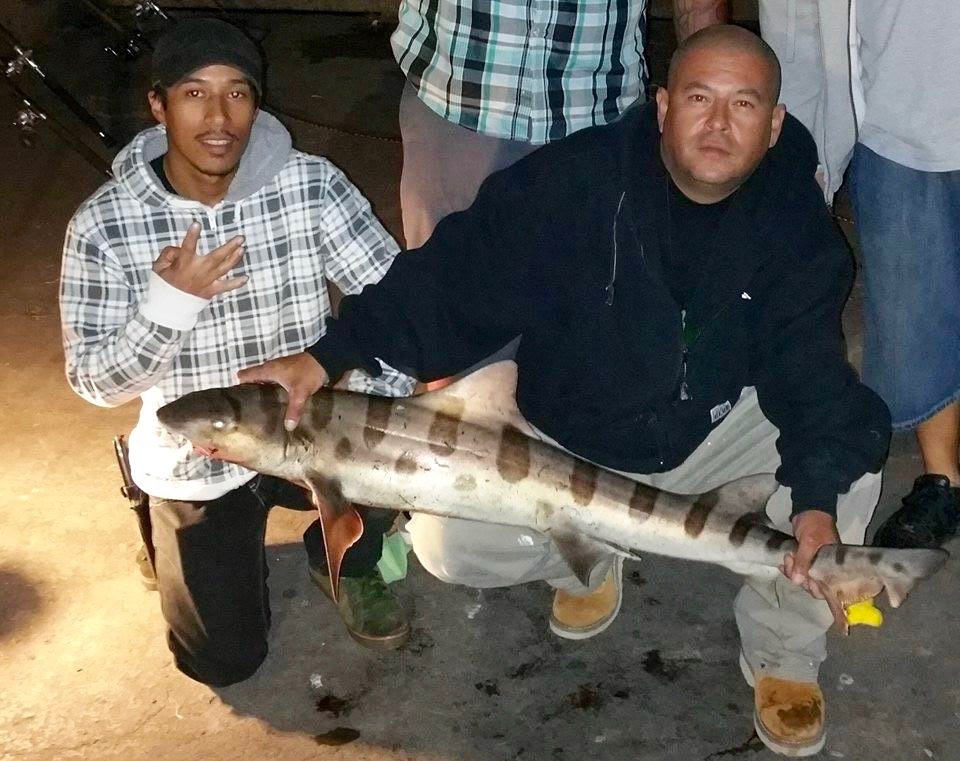
Leopard shark (Picture courtesy Wicked Homies Fishing Club)
Inshore, try using either fresh mussels or seaworms making sure to keep your hook small, usually size 6 or 8. If the tide is right, you may be able to hook some rubberlip seaperch, blackperch, halfmoon, opaleye, senorita or blacksmith in this shallow area near the rocks on the south side. For some nice-size opaleye, try using frozen peas that have been allowed to thaw; place just enough peas on the hook to cover the hook. Fishing on the north side of the pier may yield a few barred surfperch but generally action is slower than at piers built over strictly sandy bottoms.
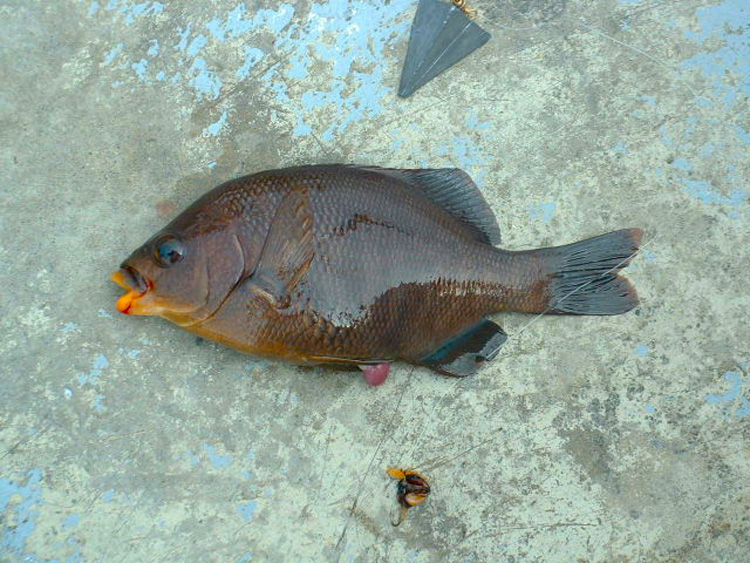
Blackperch aka Buttermouth
Sometimes the big ‘uns are lost. In August of 1998 an angler lost a HUGE bat ray which most of the locals felt had to be in the 200-pound range. They said the wings appeared to be 8-foot across but even though it was hooked with two separate treble-hook-gaffs, the anglers couldn’t get the mammoth fish up onto the pier and eventually it was lost. I’ve also heard reports, although they’re unverified, of an angler catching a diamond stingray (Dasyatis dispterura) that was nearly 5-foot in length and 100 pounds in weight.
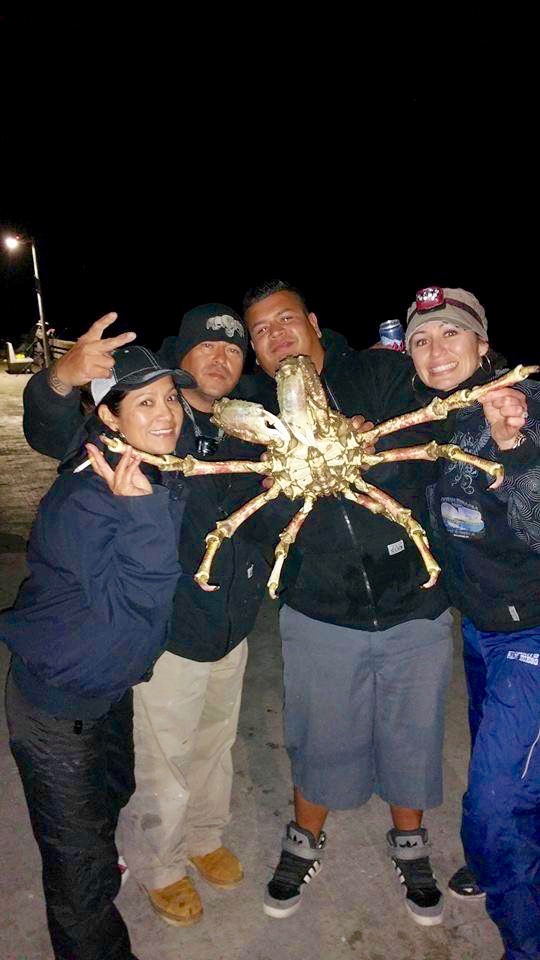
Spider (sheep) crab (Picture courtesy Wicked Homies Fishing Club)
Crustaceans. With the exception of some big, gnarly-looking spider (sheep) crabs, few crabs are caught at the pier. However, quite a few lobsters are caught at the pier — both legally and illegally. In fact, Ocean Beach is probably the best pier in the San Diego area for the bugs. Legally you can take them during the lobster season (check the latest regulation booklet for dates), they must be a certain size, and they must be taken with a hoop net. Lobsters that grab hold of fishing line are illegal and it doesn’t matter if they are big enough or if it’s in season, they are still illegal. Any lobsters that grab hold of a bait and are brought up to the pier on a fishing line should be returned to the water.
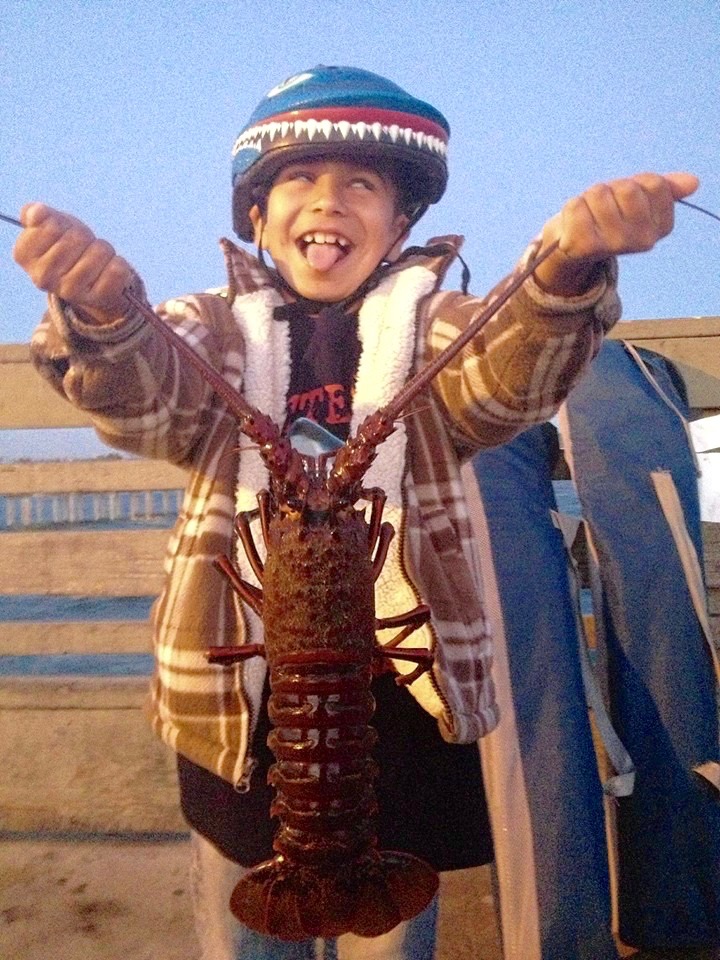
Lobsters are common — and make sure to follow the regulations
Special Recommendation. Since it is a long way out to the end of the pier, most regulars have pier carts — constructed carriers on wheels that can hold their rods and reels, tackle box, bait bucket (be sure to bring one here) and any other miscellaneous materials they need.
Special, Special Recommendation. Live bait, especially live anchovies are the best bait by far for most species. But increasingly, as the years go by, less and less live anchovies are available at bait shops. That luckily isn’t the case here; most of the time anchovies and/or sardines are available for bait. However, sometimes that isn’t the case. What should you do? Usually here, and often at Imperial Beach, Embarcadero Marina, and Shelter Island, anglers will be using drop nets to capture live anchovies and smelt. Most of the time these anglers will be glad to share their live bait, if you ask. Many anglers seem hesitant to ask and then watch enviously as others catch the fish, especially those using the live bait. Not only do I feel it is the best approach for fishing, but I feel it helps bridge the communications gap that sometimes seems to exist among our state’s diverse mix of anglers.
Potpourri — Perhaps more than you want to know about the Ocean Beach Pier
<*}}}}}}}}}>< — I found the following description of the pier in the “Lonely Planet” Guide to Los Angeles & Southern California (2005): “The half-mile long Ocean Beach Pier has all the architectural allure of a freeway ramp.” Well sure, it does sort of look like a freeway ramp if you’re standing at the shoreline approach to the pier on Niagara Avenue. But listen, what other freeway ramp provides bass, bonito, barracuda, and an occasional 7-gill shark? I might prefer an old wooden pier but “ya gots to take what you can get.”
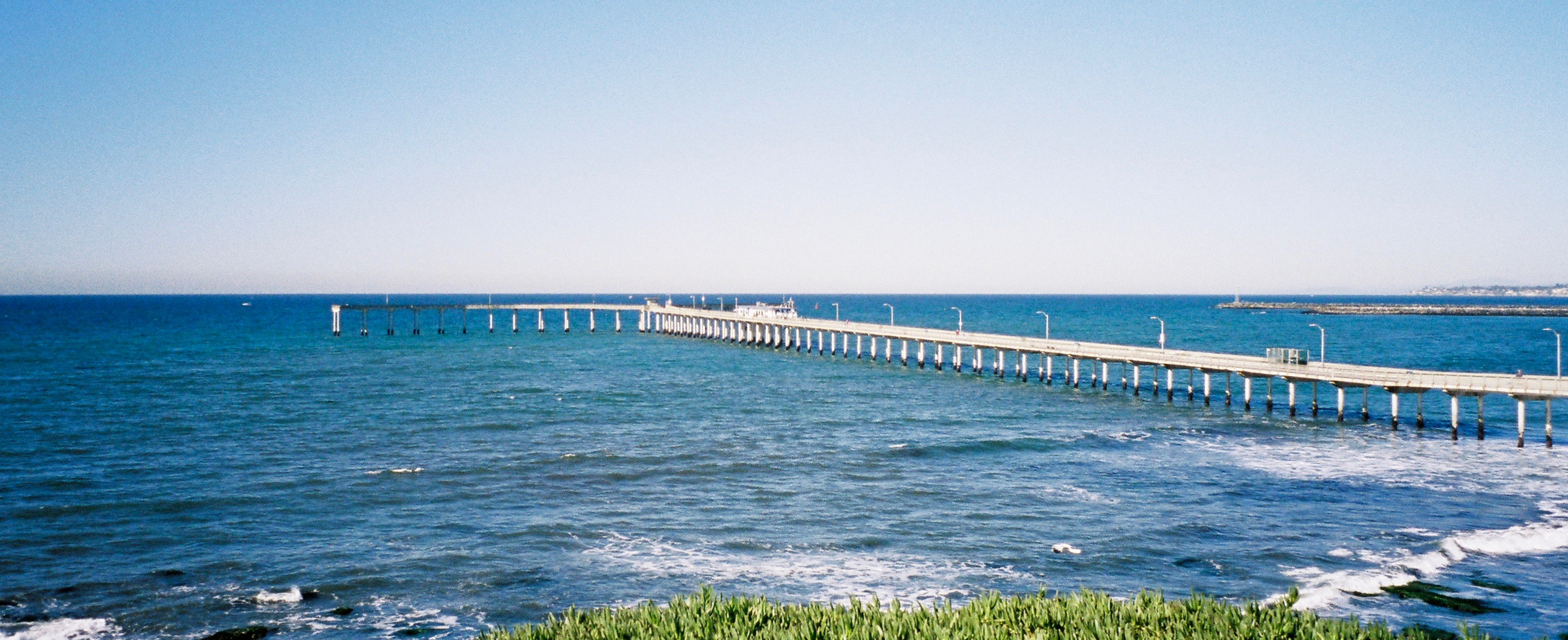
<*}}}}}}}}}>< — Fish surveys taken by the Department of Fish and Game from 2004 to 2009 show fairly typical results for a SoCal pier. The species (numerically) — northern anchovy, Pacific mackerel, queenfish, Pacific bonito, topsmelt, Pacific sardine, walleye surfperch, white croaker, yellowfin croaker, jacksmelt, salema, shiner perch, jack mackerel, kelp bass, silver surfperch, yellowtail, white seabass, thornback ray, striped seaperch, black perch, leopard shark, white seaperch, rubberlip seaperch, barred surfperch, California scorpionfish, brown rockfish, spotfin croaker and butterfish. The number of species is fairly low at 28, far below the number I have been able to document on PFIC—69. Of course if surveys had been conducted at night there is no doubt additional sharks and rays would be on the list.
<*}}}}}}}}}>< — Like many SoCal piers this one has also shown up in the world of film, in this case the television show Veronica Mars.
<*}}}}}}}}}>< — The pier has a reputation, sometimes deserved, sometimes not.
A Sense of Place: Hopes and Dreams on the Ocean Beach Pier — As the city fades away, nighttime comes to life on the pier, bringing a unique cast of characters with it
EIjah Taylor’s jangling keyboard and rhythmic voice bounces over the sound of crashing waves below. Next to him, a beaten-up hymnal, spells out the melody to “Tis So Sweet to Trust in Jesus.” An upside-down green hat teems with crumpled dollar bills and change. Taylor, a 56-year-old former reggae performer, says his donations will buy meals—at least for a couple of days. Taylor sits on the Ocean Beach Pier, decked out in all green: his knotted scarf, fingerless gloves and too-short socks, his sweater, jacket and pants. A pith helmet adorned with a small cross rests atop his head. Beneath it, dreadlocks spill down his temples, graying hair sprouts from his beard. For three years now he’s been out here on the Ocean Beach Pier, sitting, preaching, sharing God’s word. “The only real hope,” he is saying, “is to call people to Christ. So I sit here and sing.”
Everyone who walks down the pier passes him. Parents stroll by, their giggling children spinning in circles. Lovers walk arm-in-arm. Fishermen move past with armfuls of tackle. Taylor’s eyes follow them. They amble down the Ocean Beach Pier, a 1,971-foot structure that claims to be the West Coast’s longest. Each passerby carries different hopes and dreams. Some want fish. Or to finish their shift. Some seek something bigger. A post-military education. A move away from San Diego. Or just a buck for a meal.
Taylor says the Lord led him to this place. The Pittsburgh native once led a sinful life. He’s left that behind, he says, since he caught the Holy Spirit. He is talking about Anna Nicole Smith—“she’s in hell”—and Teletubbies and Ellen DeGeneres. He rails against Islam, against homosexuality, against Mormons.
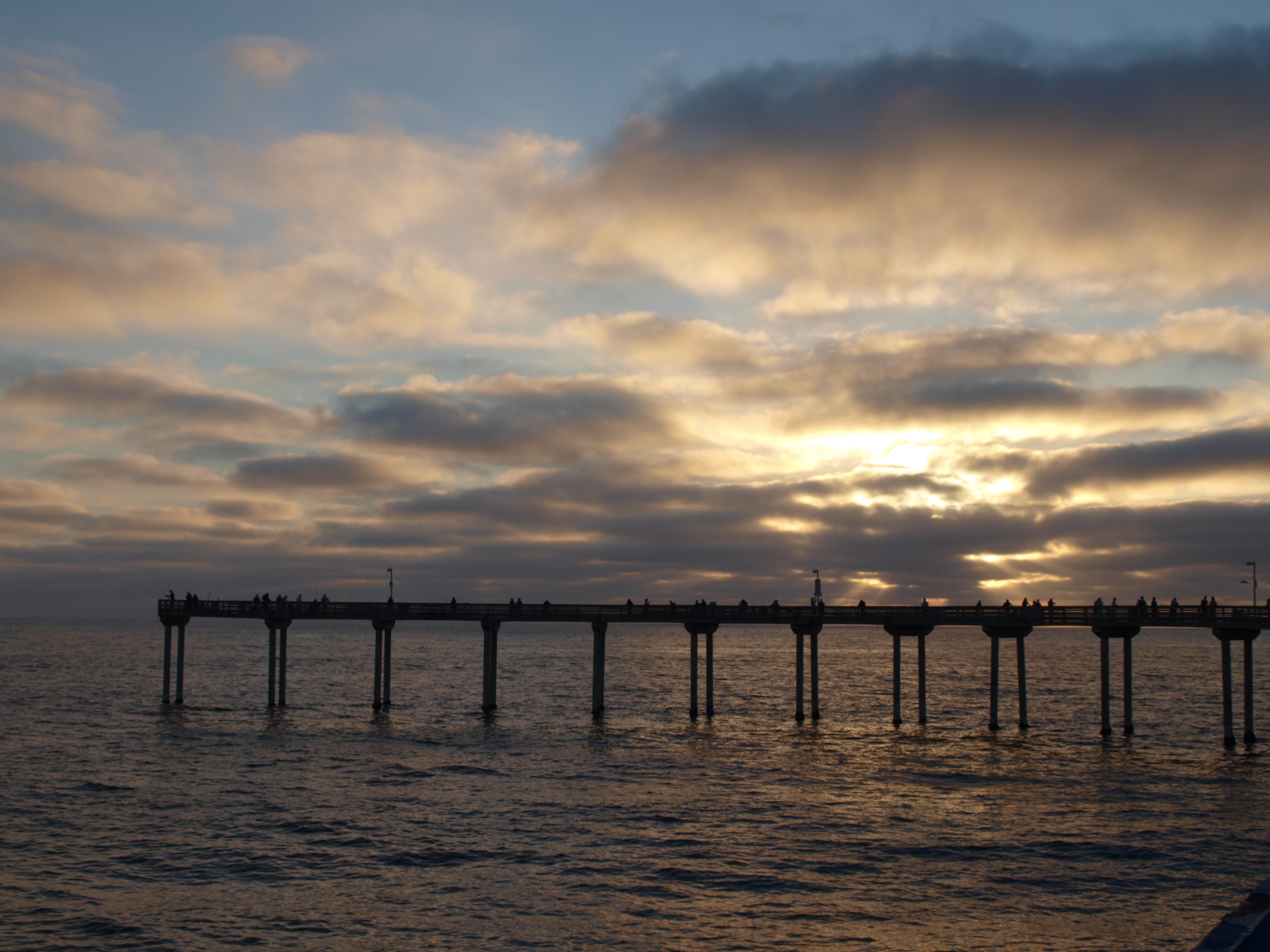
Down the pier, the evening lights begin to warm, and the gray sky slowly slips to black. Taylor says he hopes to travel north, spread the word in Oceanside, maybe farther. Until then, he sleeps in a vehicle in Ocean Beach. “This,” he says, “is what the Lord has given me.”
At the foot of the Ocean Beach Pier, the parking lot reeks of garbage, stale beer and rotting kelp. Flatulent motorcycles roar past. Cars swish and bass thumps. The sounds of a vibrant night melt into a cacophonous melody. But a few feet out on the pier, beyond the breakers and wave-starved surfers, lies a place uniquely San Diego. Out here, as evening settles in, the pier slowly awakens into its nocturnal life. Ten minutes’ walk from shore, the city soundtrack is silenced. Seals bark, the ocean gently laps, fishing lines whistle as they fly off into the sea.
The sounds of tranquility blanket the pier. After a full day of administrative work Thursday, Victor Reyes headed for the pier to burn stress. Fish started jumping as soon as he dropped his first line. “It’s just quiet,” the 27-year-old says. “You don’t have any street noise, any yelling. Just the wind, the waves, the seals.”
Nearby, Roy Johnson perfects his cast. He knows sharks are lurking, a few hundred feet out. For now, they are his target. In daytime, the 28-year-old from Chula Vista is focused on school. Southwestern College. General education for now, “just to see where it takes me,” he says. But after spending seven years in the Navy, he’s not sure what he wants to do. Journalism? Nursing? When he got out of the Navy, “everybody said I should go to school,” he says. “I said: School?”
Closing time hovers an hour away at the café midway down the pier, and Kay Zamora turns to a customer waiting for hot cocoa. You want whipped cream with that? She is slender as a rail, blonde hair fluffed up, the type of lady who won’t reveal her age. Her first day here was five-and-a-half years ago. Six years in November. Her first two weeks left her feeling nauseous, the pier rocking beneath her feet. “I don’t feel it anymore,” she says. “But, it’s good for business.” She pushes through her duties, waiting for 9 p.m., closing time. She likes her job, even on those sunny days when the crowds are thick. “It’s fun, on the water,” she says. “You can’t ask for more than that.” …
The five friends loitering around a pier bench predict their catch. A shark is going to be caught too-night! They are impatient, yanking lines up at the slightest bob, chucking mackerel fish heads into the water for chum. Bites are rare. When they do feel a nibble, they pull up a line, nearly snapping the rod. A girl bounds past and halts at the promise of fish. “Ooh! I wanna seeeee!” she squeals. Eric Fraser holds a fish-free line. “It’s seaweed.” Eric is 22, five years out of high school and wondering what’s next in life. His car was repossessed a few months ago, he’s been bouncing between jobs and getting anxious to split. San Diego is tired. Post Falls, Idaho is calling. “I went up north a few weeks ago,” he is saying. “It was heaven. Deer, bald eagle nests. People were nice up there. Pine trees. Snow. You don’t get that down here. Just bad luck after bad luck after bad luck.”
For now, Eric hops from couch to couch. No fixed address. He is talking about his experience as an extra on the TV show “Veronica Mars.” He wore a tux for the first time. Visited a college campus for the first time. It was the most funniest thing he’s ever done, he says, those three or four episodes. His four friends play fight a few feet away. They’re covered in hoodies, trading jokes, passing around a two-liter of Mountain Dew and sharing drags of cigarettes. Eric stands alone, arms slumped over the railing, dreaming of something better. He just needs to scrape together a few bucks, enough for gas.
“Me,” he says, “I just want to start over while I still have a chance.” His younger brother walks close. “You guys gettin’ any bites?” Eric asks. “I ain’t gettin’ sheeet,” his brother replies. So they pack up, loping down the pier, laughing as they walk. No sharks, no fish, hardly even a bite. Off they go, back toward home, the beckoning city.
—Rob Davis, Voice of San Diego, May 21, 2007
<*}}}}}}}}}>< — Piers are one of the places that the realities of fishing, realities that may seem brutal to the uninformed, are easily observable by non-fisherman. It leads to stories like the following.
Shark of least concern caught off pier — “No oneshould gurgle up their own blood — no one!”
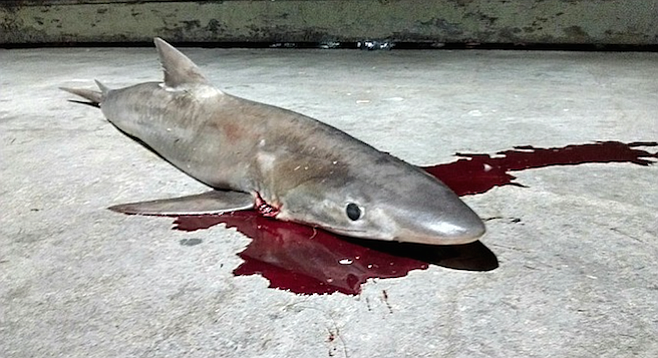
The sun was setting as Elsa Brum neared the left wing of the Ocean Beach Pier during her stroll on February 16. There she saw what looked like a baby shark gasping for air as it bled all over the pier.
“It was so wrong,” said Brum. “I felt so helpless and sad.” Brum thought about throwing the four-foot shark back into the water but it was cut through the gills.
“It was just really hard watching the animal suffer.” She contemplated calling the police but wasn’t sure what the laws were. She asked a young man fishing nearby if he had caught the shark. The man pointed toward another fisherman named José.
“José confirmed that the shark was his. I asked him what kind of shark it was and he said it was a ‘soup shark’” Confused by his answer, Brum next asked how he had caught it. José held up his hook and line and explained that he had stabbed the shark to bleed it out.
“I asked how long the shark had been bleeding there and José said for an hour…. He said he was going to use the fins for soup and the rest for fillet and ceviche.”
Even though Brum has generations of family from the fishing industry, she said, “Nothing should have to suffer like that, gasping through its own blood to survive. It was a cowardly act against a selfless being and I felt hopeless as I waited for its last breath. I was meditating in my place of peace. It was shocking. I’m about respect for all things — people, animals, and plants. No one should gurgle up their own blood — no one!”
Native San Diegan Victoria Elena Vásquez is always happy to talk about sharks. She even recently discovered a new species called a ninja lanternshark. Vásquez is a graduate student at the Pacific Shark Research Center in Moss Landing, California, and the deputy director of the Ocean Research Foundation.
“This is a soupfin shark, and though morally upsetting, there is nothing illegal going on,” Vásquez said about Brum’s photograph. “While shark fins are illegal in the state of California, catching whole sharks is not. There’s only a handful of sharks that are illegal to catch, like great white and basking sharks. Therefore, if the person took the whole shark home and made dinner for themselves, it’s not illegal. On the bright side, this species is very healthy in the Northeast Pacific.”
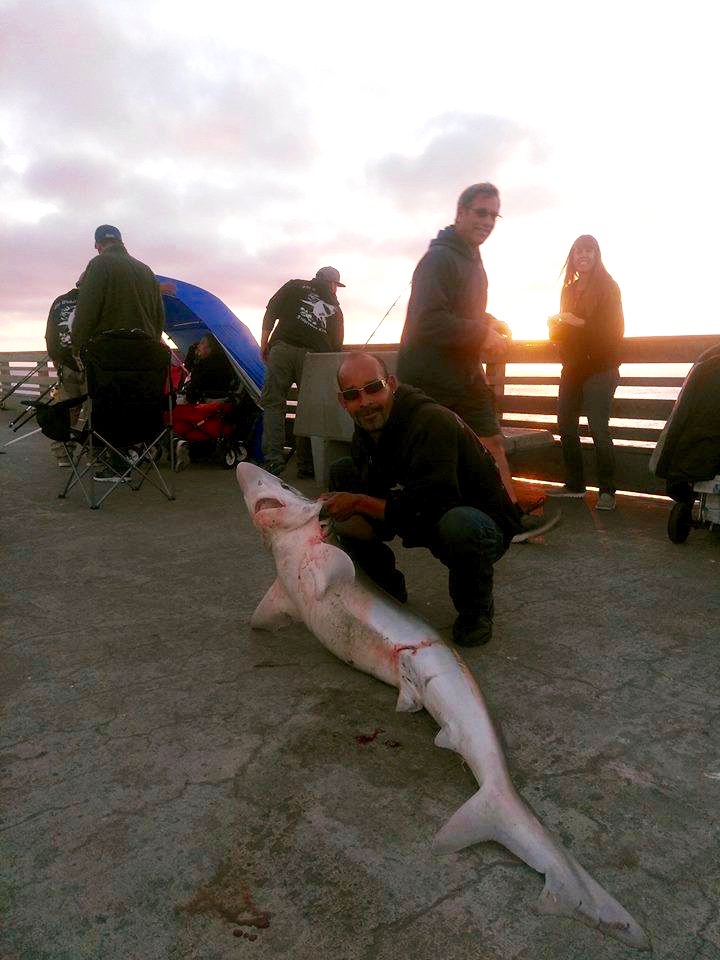
Soupfin shark — 2017 (Picture courtesy Wicked Homies Fishing Club)
Vásquez pointed out that while females of this species are common in San Diego, a male is a unique find. She collects data on soupfins and hammerheads and said that the public can help by reporting any they find.
While people are allowed to catch soupfin sharks of any size, Vásquez warns, “In general, sharks tend to have higher concentrations of mercury than other seafood options, so despite the legality, I would caution people about eating shark and ray on a regular basis.”
“Soupfin sharks have had a long history of being overfished in California. Even though they have an unfortunate common name, soupfin sharks were mainly targeted in the 1940s for their oily livers, not their fins. Once that fishery ended, soupfin sharks in our area rebounded.”
“In our waters [the Northeast Pacific], soupfin sharks are listed as ‘Least Concern’ by the International Union for Conservation of Nature Red List Assessment. However, being overfished is still an issue for them in other parts of the world, such as the waters off Argentina and Brazil, where they are Critically Endangered.”
Joe Stewart used to fish once upon a time. Regarding the shark being bled out, Stewart said, “If you don’t bleed them while their hearts are still pumping, waste products in the blood can taint the meat.”
Say what you want about the ethics and humanity of it all, fishing has been a way of life and sustenance for thousands of years. And seafood is directly linked to the evolution of the advanced frontal cortex — that same part of the brain that has some people so sensitive about this in the first place.”
—Julie Stalmer, February 18, 2016, San Diego Reader
<*}}}}}}}}}>< — It’s not every day you catch a 100-pound shark.
Man fishing from pier lands 7-foot shark
A man fishing with his family last night off Ocean Beach Pier caught a 7-foot shark estimated at more than 100 pounds. Inez Chavarin, his wife, Maria, and their three daughters usually fish for bass off the pier. Around 8 p.m., he cast his 50-pound line into the Pacific, and a thresher shark hit. It was so big the 34-year-old Chavarin couldn’t lift it without help from others who were also fishing on the pier. He had to call a relative to bring a truck big enough to carry it back to the family’s home in City Heights
“We’re going to eat it,” he said of the biggest catch of his life, while his wife wondered about what they were going to do with all that meat. “Everyone’s going crazy here, nobody’s seen anything like it,” said Miriam Schraer, who was taking a stroll on the pier when she saw the excited crowd gawking at the shark.
Chavarin said he used his usual bait, mackerel. But when he made the big strike, he used a large fishing spear to land the shark. “I don’t know what we’re going to do about cleaning it,” he said, his excitement wavering a bit at the prospect.
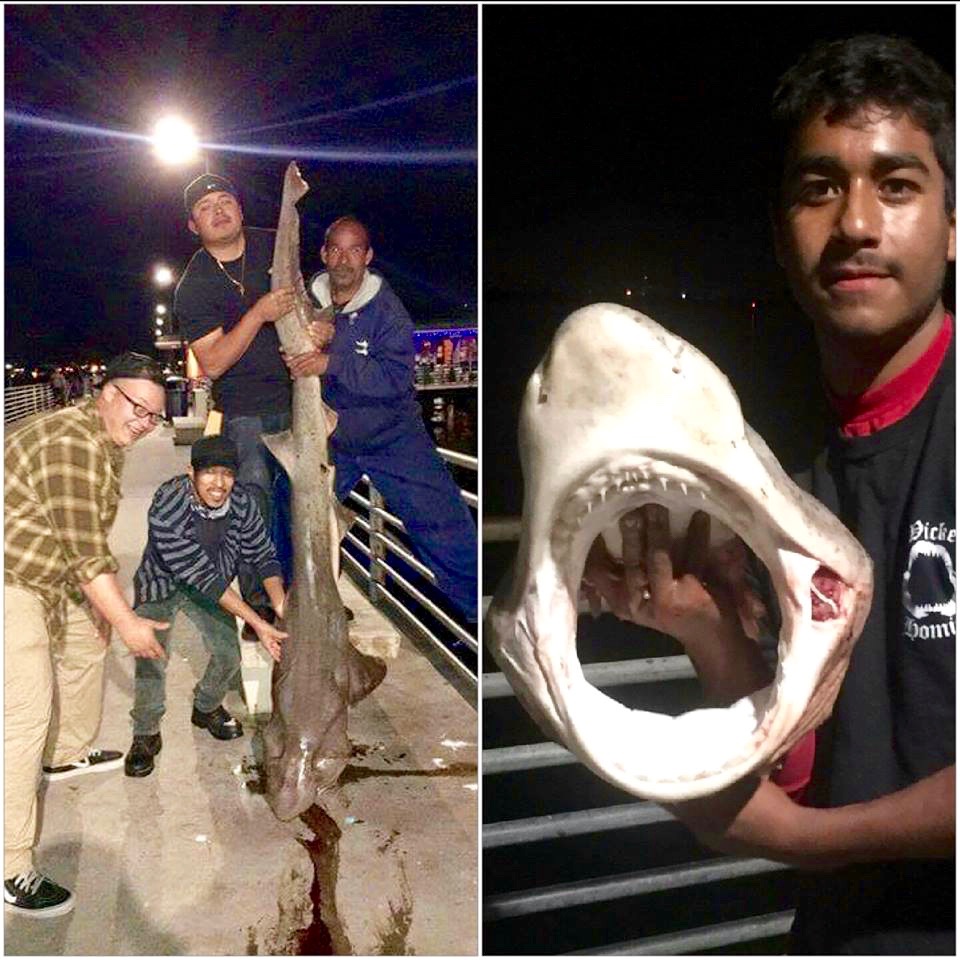
7-Gill taken in 2016 (Picture courtesy Wicked Homies Fishing Club)
Thresher sharks can grow up to 160 pounds and 20 feet long and are a common sight in San Diego waters. San Diego lifeguards say they aren’t a threat to people.
“They’re a beautiful animal, people can hook them, but it takes a lot of finesse to catch a big one off a pier,” said lifeguard Bill Bender.
—Lisa Petrillo, San Diego Union-Tribune, September 18, 2006
<*}}}}}}}}}>< — I rarely recommend restaurants for the piers but sometimes one will deserve deserve a little publicity and such is the case with the OB Pier Café.
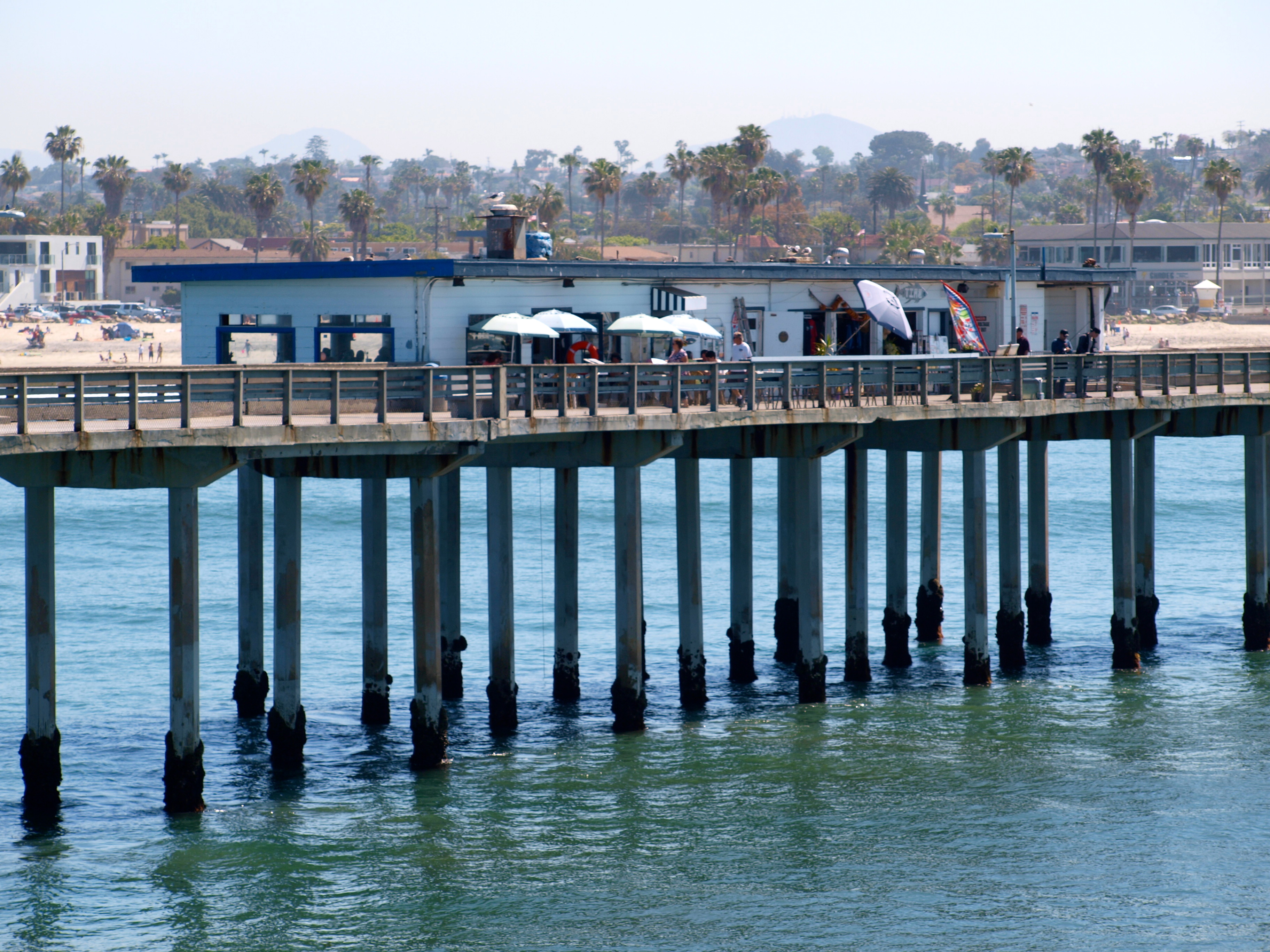
Restaurant Review: Ocean Beach Pier Café — San Diego Journals
Reviewed by El Gallo on 8/24/2000.
Halfway Out Ocean Beach Pier, San Diego — Type of Dining: Other — Type of Cuisine: Other — Member Recommendation: Highly Recommended — Price Range: Less than US $10 — Attire: Clothing recommended, but not always observed — Reservations: N/A
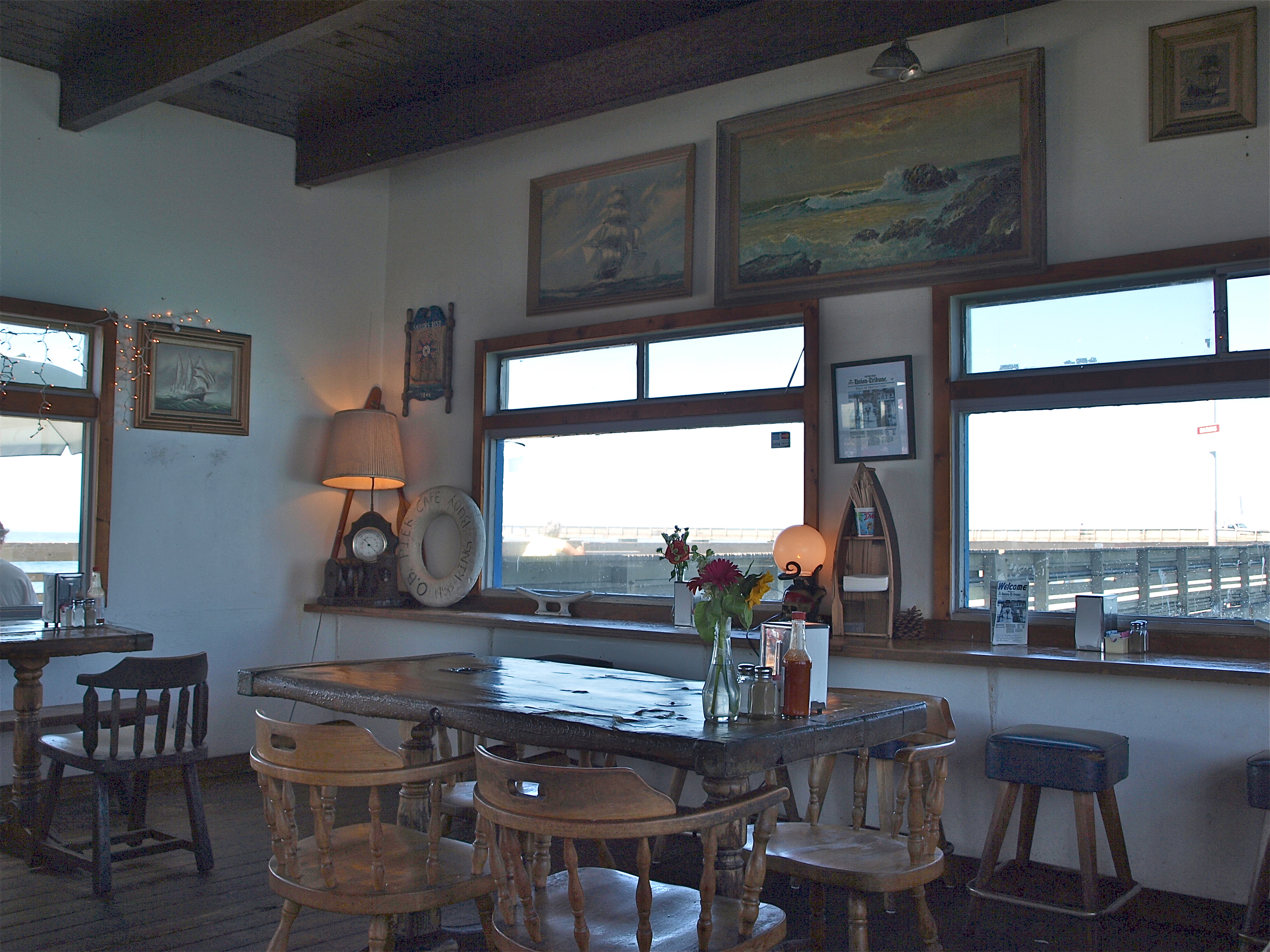
My favorite place to eat, sip tea, watch the surf, catch the rays and feel the motion of the pier. This is pretty unique—a restaurant out on a West Coast pier–and with the laws now, it’s likely to stay pretty unusual. The decor inside is sort of Nautical Kitch, but nice. Fishnets, portholes, a big brass telegraph that kids just love to slam from Full Ahead to Full Astern like in the movies. Heavy wood hatch cover tables. And two sides are windows with the kind of view you don’t get anywhere else. Nice shelter on blowy or stormy days. But in San Diego those days are rare–so take a seat at the tables outside—and out here on the pier you are REALLY outside.
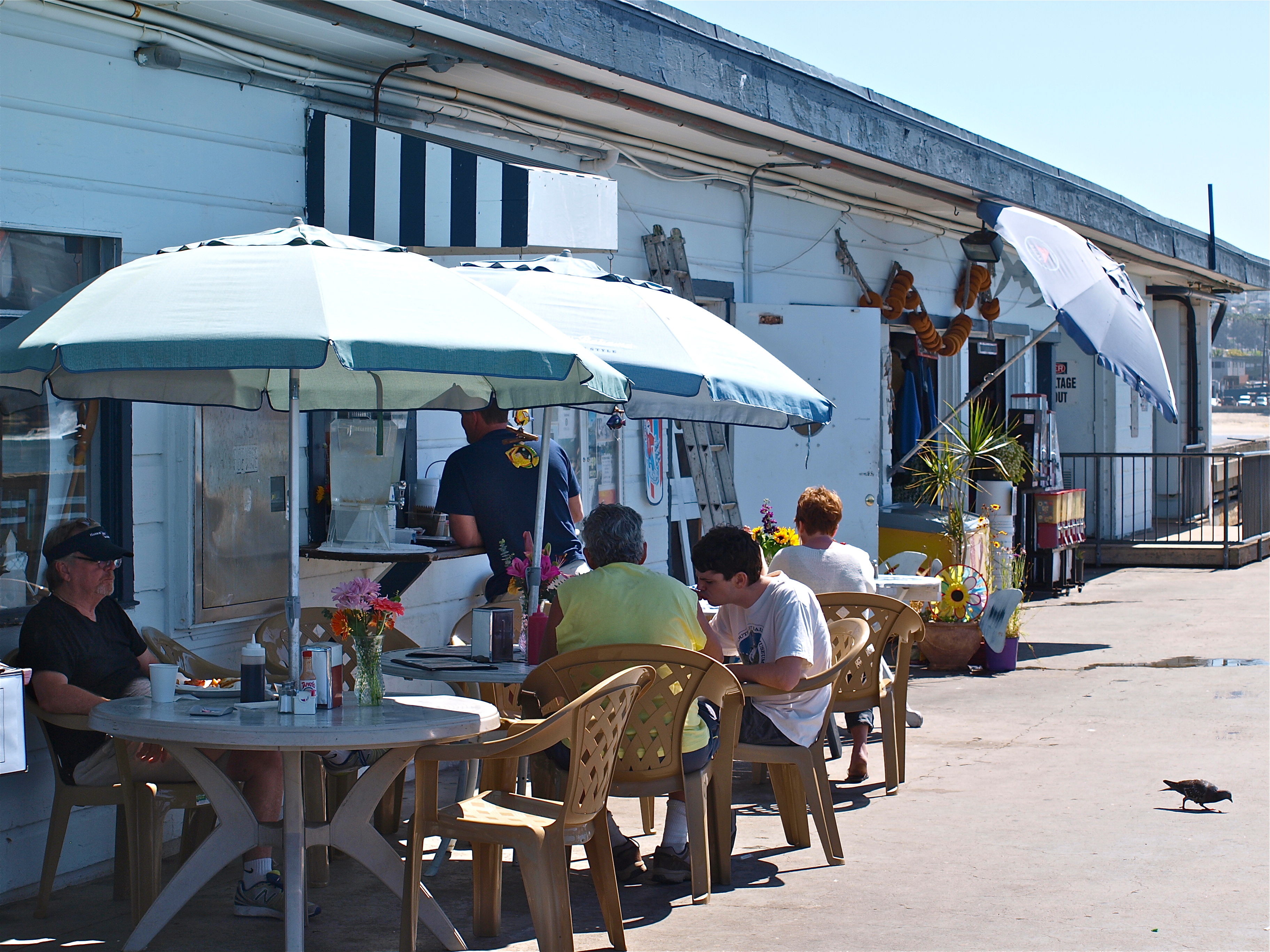
When big waves hit the bottom of the pier, you don’t hear it; you feel it. You are out there poised between earth and sky, a beautiful environment. Look south at the tide pools and all the way to Mexico, or North at the river, Mission Beach, and the beginnings of La Jolla. Watch the surfers, pelicans and gulls. Have a latte. Now, what stupid stuff were you worried about? But this is not just a bait shop with a view—it’s a real restaurant and a good one, with unique dishes you will remember and tell friends about. Okay, there are other places where you can get clam chowder in a bowl made of a scooped-out sourdough roll—the OBPC’s idea of recycling dishes. But when was the last time you had a lobster taco, or lobster omelet? But there’s no need to get exotic—just try the eggs and machaca. If it’s busy, you can just order ‘to-go’ from the outside window and eat walking along the pier, sip coffee out at the deep end. See the gull? Be the gull.
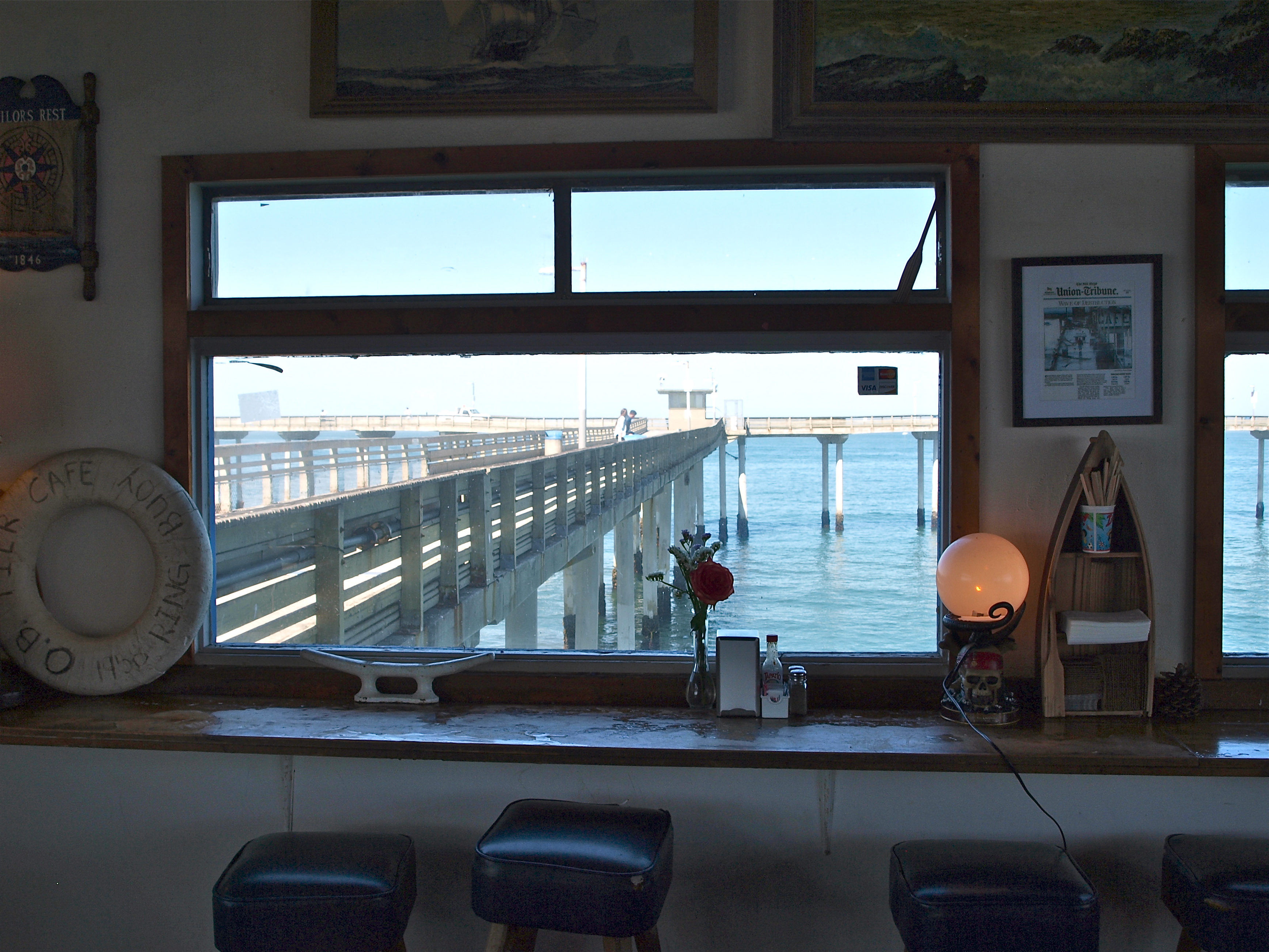
History Note. The town of Ocean Beach was laid out and named in 1887-88 by developers Billy Carlson and Frank Higgins. They built a resort hotel, the Cliff House, subdivided their land into lots, and used promotions such as band concerts and mussel roasts (one reason for the early name “Mussel Beach”) to drum up business. But the site was a long 2-1/2 hour carriage ride from downtown San Diego, too far for most. Eventually the partners rented a locomotive and began the Ocean Beach Railroad. Passengers could take a ferry from downtown San Diego to the Roseville Wharf on Point Loma where they connected by train to the Cliff House. However, an economic downturn stalled growth. Eventually the Cliff House burned down following a fallen chandelier in 1898 and Carlson sold the development to an Eastern financier.
On July 4, 1913 the Wonderland Amusement Park opened at the north end of Ocean Beach on the sand between Voltaire and Abbott Streets. The park had a large roller coaster, roller-skating rink, merry-go-round, dance pavilion and children’s playground; 22,000 lights outlined the buildings. The park was a popular spot to take the family until 1916 when most of the park was washed away by high tides.
For many years’ residents of the area clamored for a fishing pier. Their cries were answered when, in 1915, a bridge was built across the mouth of Mission Bay by the Bay Shore Railroad Company. It was 1,500 feet long and extended from the north end of Bacon Street in Ocean Beach to the tip of the sand dunes that we know today as Mission Beach. Its main purpose was transportation, and soon a “Toonerville Trolley” was installed to haul people from “Wonderland” across the sand dunes—via the bridge.
Anglers, however, also flocked to the bridge, a wooden structure with chest high railings and a sidewalk on each side. Over time, it became known as the “Old Fishing Bridge.” There was a bait house at the end of the bridge that sold crawfish (ghost shrimp?), minnows, clams and mussels but fishing for the most part appeared to be only fair. Reports indicate that anglers caught numerous sharks and stingrays while spearfishermen concentrated their efforts on mullet and needlefish (although it would appear to be difficult to spear the skinny little needlefish). The largest catch was undoubtedly a 331-pound sea turtle that was speared one day. The enterprising anglers sold it for $9 or just 3 cents a pound.
When the bridge was removed in 1951, local anglers once again began to talk of the need for a pier. It would take more than a decade, but the Ocean Beach Pier (originally called the San Diego Fishing Pier) would be the result. The new pier opened on July 2, 1966 to the scene described above.
The City of San Diego, given more than $900,000 by the Wildlife Conservation Board for a new public fishing pier at Ocean Beach and which is 60% complete, decided that it should be extended 200 feet and approved a $30,000 additional appropriation, which the WCB matched at its meeting in Sacramento late Monday.
There was so much intense interest in the pier that private groups started a drive for an additional $30,000. Thousands of individuals, small businesses, community groups, school children, service clubs and others raised another $30,000.
WCB executive officer Ray Nesbit said that it was one of the greatest expressions of community spirit that he had ever witnessed.
With 400 feet of added rail space, it will make the Ocean Beach Pier one of the best along the Southern California coast. Up to 100,000 angler days of additional use will result., Nesbit said, forecasting a half million angler days of use when the pier is completed.
The new funds will enable the contractors to extend one wing of the pier southward into an area where presently boat anglers make good catches of bonito, halibut, barracuda, kelp and sand bass, and at times yellowtail and white sea bass.
—Donnell Culpepper, Long Beach Independent-Press Telegram, December 19, 1965
The opening day celebration, on July 2, 1966, saw a crowd of 7,000 people, various state and local poobahs, and an eclectic mix of activities. The highlight was a parade down Voltaire Street that included an eclectic mix of groups—the Marine and Navy marching bands, the House of Scotland Junior Pipe Band, the San Diego Unicycle Clowns, and the Junior Daughters of the Sphinx. As is usual at such parades there had to be beauty queens and here there were a dozen. The highlight for some was an “Anti-Litter Animated Pelican.”
Of course there almost had to be a song and here it was the “The Ocean Beach Song,” a song written specifically for the celebration. The song makes you wonder if it was commissioned by the Chamber of Commerce or local Realtors.
“The Ocean Beach Song” by Lee McCumber
“The wide world’s finest fishing pier
Lures a host of anglers here
Sportsmen if you want some fun
Here’s the best beneath the sun
Happiness within your reach
When you live in Ocean Beach”
Unfortunately the utilities for the pier café had not yet been turn on so Tom Ham (of Tom Ham’s Lighthouse) turned some leftover wheelbarrows into barbeques and made hamburgers for the crowd (all 7,000 of them?).
Luckily, the pier has seemed to withstand the tides of time fairly well although, sooner or later, storms and/or age will do their damage. Several times the pier has been closed by storms and has needed repairs. In 1991 a $1.9 million dollar repair project was completed and then the pier was closed for several winter months in 1998 due to El Niño generated storms and high tides. After the storms subsided, and railing were repaired, the pier opened once again. The pier was damaged again in March of 2003 and in 2008; both times it was opened within a few months.
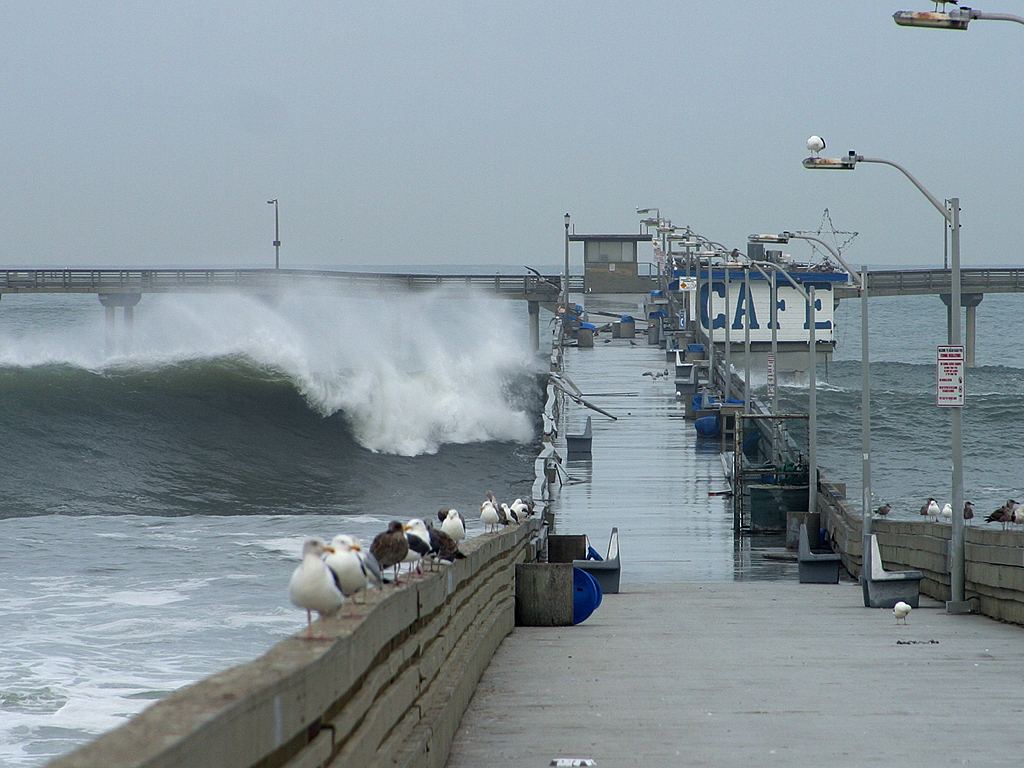
Winter storms seem to frequently force the pier to be closed for a day or two — Picture courtesy John Sullivan
As for the rest of Ocean Beach (OB to locals)? By the ‘50s Ocean Beach was a typical SoCal beach town; by the ‘60s surfing became an important feature of the OB cultural life; by the ’70s it had attracted its share of hippies and was called the “Haight-Ashbury” of San Diego; and by the ‘80s it seemed to start a slow decline. Today the beach area’s an amalgamation of all those diverse influences and marches to a slightly different drummer than most of the other areas in San Diego. OB reflects, to a degree, a synthesis of NorCal hippie populism mixed with SoCal flip-flop casual and it’s an interesting mix.
Ocean Beach Pier Facts
Hours: Open 24 hours a day.
Facilities: Restrooms, bait and tackle shop, fish cleaning stations, benches and lights. There is free 24-hour parking in a small parking lot near the foot of the pier. The Ocean Beach Pier Café sits next to the bait shop and offers up good eats. You might want to try the mango pancakes or the lobster tacos.
Handicapped Facilities: Access to the pier is from the public parking lot and then up a number of stairs (which are steep) or by a block-long public ramp. There is posted handicapped parking and restrooms. The surface is concrete and the railing is 42 inches high.
Location:32.74861 N. Latitude, 117.25528 W. Longitude
How To Get There: From the north take I-5 to the Sea World Dr. exit and follow it until it turns off to Sunset Cliffs Blvd. From the south take I- 5 to the Nimitz Blvd. exit, then follow that road to Sunset Cliffs Blvd. Follow Sunset Cliffs Blvd. to Newport Ave., turn right and follow the road to the pier parking lot
Management: City of San Diego, Parks and Recreation Department.
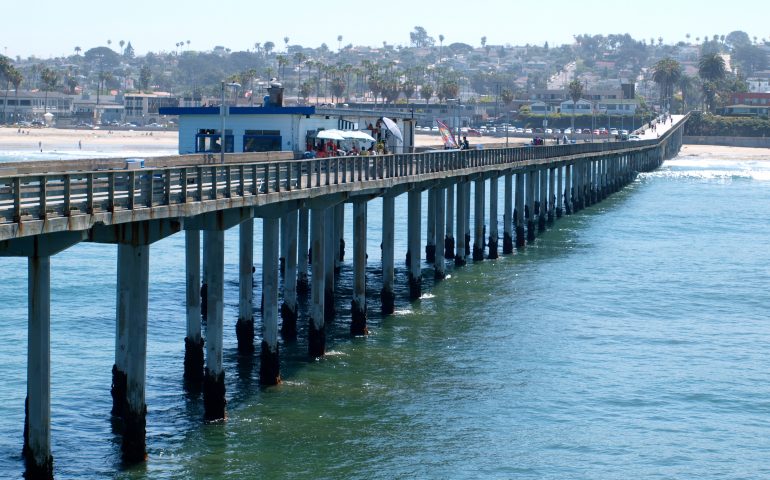
can you use crab nets on the OB fishing pier? Also, what is the best bait to catch good edible fish?
My mom cut the ribbon to the pier on opening day. The pictures are pretty cool to look back on.
Growing up in ob , in the fifties and sixty’s , WOW the very best years of my life swimming surfing and fishing so much more
Excellent read. I was at OB Pier the day it opened and have been going there ever since.
My take on the degradation of the fishing is the availability of good bait. When it first opened
Live anchovies. live pismo clams and other fresh baits were available. Not now. However if
I take the time to harvest fresh bait- clams, mussel, ghost shrimp or even smelt and
anchovies (sabiki or hoop net) my likelihood of success increases exponentially. In the
seventies I saw one regular catch black sea bass regularly off the south arm on the
ocean side. He used a 12-14′ surf rod and would cast out to the kelp bed. He would use a large
bobber and would cast out about 100 yards. These were not huge as black sea bass go
but a decent catch nevertheless. He would catch two-three and stop there. I do believe
that the area has been over fished by the take of small fish. I had one lady get mad at me for
throthrowing back an eight inch calico bass. Once walking out several years ago I saw a guy
fighting a large bat ray. this ray fried his Ryobi spinning reel which I just happened to have.
We switched my reel onto his rod and switched his spool over. We gradually increased the
We accomplished that part but then when the ray again felt resistance the fight was again
on. it eventually snapped the line. We high fived and left with a great memory. Sometimes
it’s not the fish you catch but the one you don’t that leaves a lasting memory.
What is left out of all these histories of the Ocean Beach Pier is that it was designed by the architectural and engineering firm of Lykos and Goldhammer. My father, Sidney Goldhammer, was the engineering partner. Since this was more of an engineering feat, as opposed to an architectural feat, he did most of the design work. And before the pier was officially opened, due to my Dad’s contacts with the contractors, we were able to get onto the pier one morning during final construction for some fishing. Like most were complaining about after it officially opened, we caught nothing. But we had fun. It is sad to see the life of the pier coming to an end. Over the years, whenever I or my brother or sister would make a trip to San Diego we would make a point of going to Ocean Beach for a walk of the whole pier in memory of our father, Sidney Goldhammer
Many,many great times spent with family and friends on that Pier will hate to see it go but we need an updated one to accommodate the tourism and local businesses that depend on that Pier to bring in the business,
So many times just relaxing out there even if you didn’t catch anything you would catch Peace ️
I just hope I’m still around when the new one is opened as to say tomorrow is never promised, it’s going to be a painful time from here on out with the closing of the Pier and I know small business will take a blow from it and I hope they will survive until it opens once again, we all have memories to share about that piece of iconic history.
Well here’s to the future for more memories to be made for our next generation of people to create God bless you all.!!!!
It will be an especially sad day for me when the pier is demolished.
My dad operated the drill rig that
bored the holes the pilings are sunk into. I ask him “Pop, how many of them did you drill?” He answered “Every last one of them SOBs.” That was my dad, blunt and straight to the point.
Ocean Beach Pier is a great place to fish. But even if you don’t fish, the scenery is beautiful. You can see surfers, dolphins, and even whales.
We all have memories to share about that piece of iconic history, so I just hope I’m still here when the new one opens because, as they say, tomorrow is never guaranteed. The closure of the Pier will be a painful time going forward, and I know small businesses will suffer from it. I hope they will endure until it reopens.